4.5: West Africa
- Last updated
- Save as PDF
- Page ID
- 147761
West Africa
From rich textiles and elaborate masquerades to some of Africa's most well-known architecture.
13th century - present
About West Africa
by SMARTHISTORY
West Africa includes Benin, Burkina Faso, the Cape Verde Islands, Gambia, Ghana, Guinea, Guinea-Bissau, Ivory Coast, Liberia, Mali, Mauritania, Niger, Nigeria, the island of Saint Helena, Senegal, Sierra Leone, Sao Tome, Principe and Togo.
Burkina Faso
Mask (Nwantantay) (Bwa peoples)

Among the southern Bwa peoples in Burkina Faso, large wooden plank masks are carved to represent various flying spirits that inhabit the natural world. These spirits, though largely invisible, are associated with water and can take physical form as insects that gather around a pool after a heavy rain or as a large water fowl, like an ibis. Some Bwa describe a mythological encounter in which a flying spirit appeared before a human, offering protection and service. A tall plank mask was created after this encounter to honor the spirit and ensure its continued beneficence.
This mask has a circular face and tall, vertical superstructure with a series of downward-curving hooks projecting from both the front and the back. The protruding, diamond-shaped mouth with jagged teeth is pierced to allow the wearer to see. Brightly painted patterns in red, black, and white enhance the bold geometric shape of the plank. These designs refer to important Bwa ideals of social and moral behavior that are taught over the course of initiation. Each symbol has multiple levels of meaning that older initiates reveal gradually to novices as they mature. The checkerboard pattern of black and white squares, for example, refers on one level to the animal skins on which people sit: white representing the clean, fresh hides assigned to youths and black suggesting the darkened skins owned by elders. On a less literal level, the juxtaposition of white and black squares suggests abstract concepts such as the separation of good from evil, and of light from dark.
Nwantantay masks are part of diverse ensembles of masks that represent animals, insects, humans, and supernatural creatures. The masks are commissioned and owned by large, extended families, or clans. The masks are used on several occasions throughout the year, including initiations, burials, annual renewal rites associated with planting and harvesting, and ceremonies celebrating the consecration of a new mask. These events are often competitive, with individual clans striving to present the most elaborate and inventive performance in the community. The mask is worn by a skilled dancer who secures it over his face by gripping a fiber rope on the mask’s back with his teeth. His body is concealed by a bushy fiber costume, traditionally dyed red or black, but now also seen in the bright green, yellow, and purple of European dyes. Accompanied by musicians playing flutes and drums and women singing songs, the masquerader moves rapidly, imitating the behavior of a flying spirit. With fiber costume twirling, he twists back and forth, then dips low to the ground, rotating the mask to suggest a disembodied apparition.
The tradition of carving and performing wooden masks is a recent one among the southern Bwa, adopted within the past hundred years from the neighboring Nunuma and Winiama peoples. Previously, the Bwa had created masks of leaves, vines, and grasses for use in ceremonies honoring Do, the earthly representative of the creator god. Resulting from the constant interplay of people and ideas, this example of cultural borrowing demonstrates the dynamism of masking traditions in the region and, in particular, the openness to innovation and adaptation that characterizes Bwa culture.
© 2006 The Metropolitan Museum of Art, New York (by permission)
Additional resources:
This work at The Metropolitan Museum of Art
Christopher D. Roy, The art of Burkina Faso on Art & Life in Africa (University of Iowa)
Do in Leaves and Wood Among the Bobo and the Bwa from Art and Life in Africa (University of Iowa)
Smarthistory images for teaching and learning:
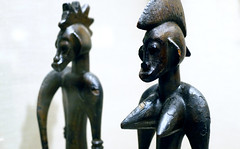


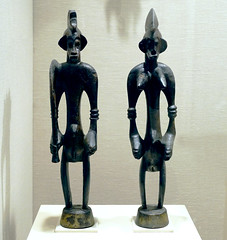
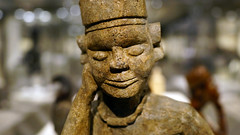
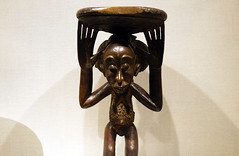



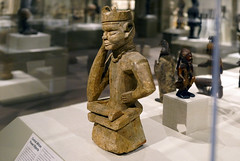
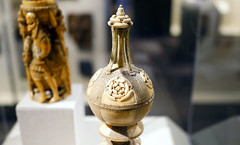
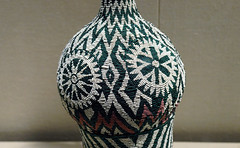
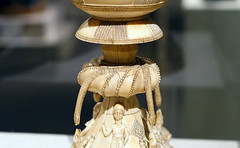
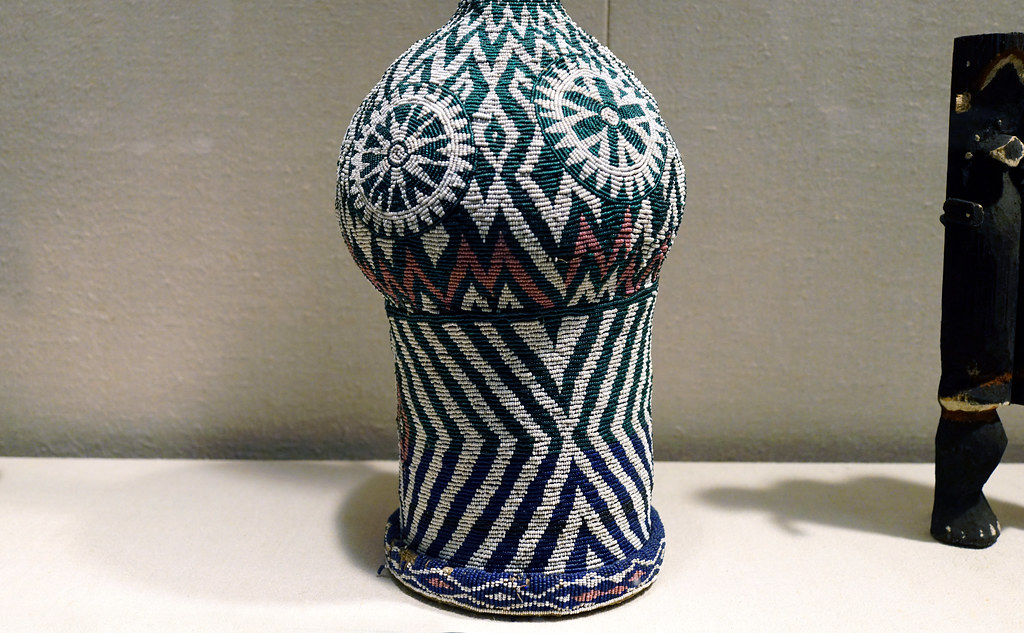
The art of Ghana
From Kente cloth to the metallic textiles of El Anatsui.
17th century - present
Golden Stool (Sika dwa kofi), Asante peoples
by DR. PERI KLEMM and DR. BETH HARRIS
Video \(\PageIndex{1}\): Golden Stool (Sika dwa kofi), Asante Peoples (Ghana), c. 1700 and Asante weights (University of Pennsylvania Museum of Archaeology and Anthropology)
It took a miracle to bring this golden stool to Earth—and another one to keep it out of British hands.
Smarthistory images for teaching and learning:












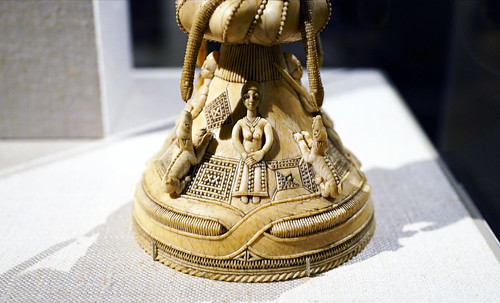
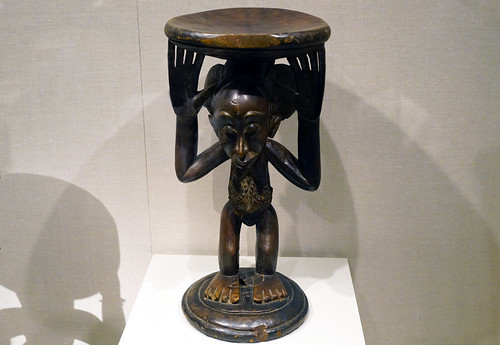
Linguist Staff (Okyeamepoma) (Asante peoples)
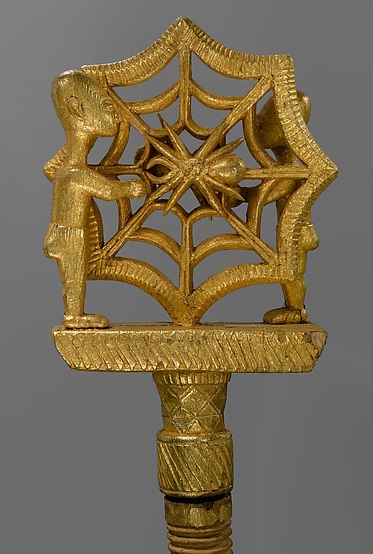
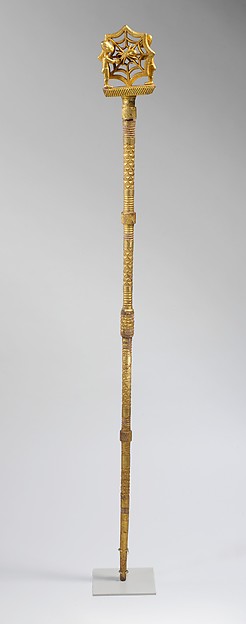
This magnificent gold-covered staff was created to serve as an insignia of office for an okyeame, a high-ranking advisor to an Asante ruler. The position of okyeame encompasses a broad set of responsibilities, including mediation, judicial advocacy, political troubleshooting, and the preservation and interpretation of royal history. The okyeame’s most visible public role is as principal intermediary between the ruler and those who seek his counsel, leading to the popular characterization of his profession as being that of a linguist. Drawing upon vast knowledge and considerable oratorical and diplomatic skills, the okyeame eloquently engages in verbal discourse on behalf of the chief and his visitors. He relays the words of visitors to the king and transmits the king’s response, often with poetic or metaphorical embellishment.
Imagery on the finial of linguist staffs typically illustrates Asante proverbs about power and institutional responsibilities. Here, a spider on its web is flanked by two figures, representing the proverb: “No one goes to the house of the spider to teach it wisdom.” The spider is a fitting symbol for respect due to a person with great oratorical and diplomatic skills. In Ghana, Ananse the spider is the bringer of the wisdom of Nyame, the supreme creator god of the Asante, and is the originator of folk tales and proverbs. The staff is composed of a long wooden shaft carved in two interlocking sections and a separate finial attached to the base. It is covered entirely with gold foil, a material that alludes to the sun, and to the vital force or soul contained within all living things.
Although the institutional office of okyeame is believed to be centuries old, the use of figural wooden linguist staffs as insignia is probably a more recent development. Prior to the late nineteenth century, linguist staffs took the form of a simple cane, a tradition likely borrowed from European prototypes in the mid-seventeenth century. During the late nineteenth to early twentieth century, the British gave official staffs, often made with figural finials, to Akan chiefs who represented the colonial authorities. Since 1900, hundreds of figural linguist staffs have been carved not only for linguists but also for representatives of other institutions, such as associations of fishermen, carpenters, and musicians.
The Asante kingdom, part of the larger Akan culture, was formed around 1700 under the leadership of Osei Tutu. Osei Tutu brought together a confederation of states that had grown wealthy and powerful as a result of the area’s lucrative trade in gold, sold to both northern merchants across the Sahara and European navigators. The centralized system of government that emerged was a complex network of chiefs and court officials under a single paramount leader. A variety of gold regalia was used to distinguish rank and position within the court.
© 2006 The Metropolitan Museum of Art, New York (by permission)
Additional resources:
This work at The Metropolitan Museum of Art
Art of the Asante Kingdom on The Metropolitan Museum of Art’s Heilbrunn Timeline of Art History
Gold in Asante Courtly Arts on The Metropolitan Museum of Art’s Heilbrunn Timeline of Art History
Smarthistory images for teaching and learning:














Kente cloth
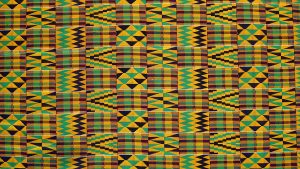
Inspired by a spider’s web
Among the Asante (or Ashanti) people of Ghana, West Africa, a popular legend relates how two young men—Ota Karaban and his friend Kwaku Ameyaw—learned the art of weaving by observing a spider weaving its web. One night, the two went out into the forest to check their traps, and they were amazed by a beautiful spider’s web whose many unique designs sparkled in the moonlight. The spider, named Ananse, offered to show the men how to weave such designs in exchange for a few favors. After completing the favors and learning how to weave the designs with a single thread, the men returned home to Bonwire, and their discovery was soon reported to Asantehene Osei Tutu, first ruler of the Asante kingdom. The asantehene adopted their creation, named kente, as a royal cloth reserved for special occasions, and Bonwire became the leading kente weaving center for the asantehene and his court.
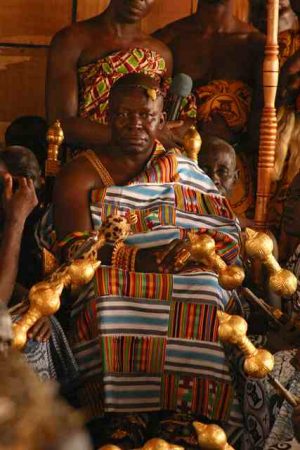
A royal cloth
Originally, the use of kente was reserved for Asante royalty and limited to special social and sacred functions. Even as production has increased and kente has become more accessible to those outside the royal court, it continues to be associated with wealth, high social status, and cultural sophistication. Kente is also found in Asante shrines to the deities, or abosom, as a mark of their spiritual power.
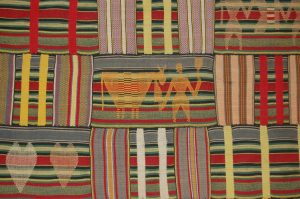
Historians maintain that kente cloth grew out of various weaving traditions that existed in West Africa prior to the formation of the Asante Kingdom. These techniques were appropriated through vast trade networks, as were materials such as French and Italian silk, which became increasingly desired in the 18th century and were combined with cotton and wool to make kente.
Kente cloth is also worn by the Ewe people, who were under the rule of the Asante kingdom in the late 18th century. It is believed that the Ewe, who had a previous tradition of horizontal loom weaving, adopted the style of kente cloth production from the Asante—with some important differences. Since the Ewe were not centralized, kente was not limited to use by royalty, though the cloth was still associated with prestige and special occasions. A greater variety in the patterns and functions exist in Ewe kente, and the symbolism of the patterns often has more to do with daily life than with social standing or wealth.
Weaving kente
Kente is woven on a horizontal strip loom, which produces a narrow band of cloth about four inches wide. Several of these strips are carefully arranged and hand-sewn together to create a cloth of the desired size. Most kente weavers are men.
Weaving involves the crossing of a row of parallel threads called the warp (threads running vertically) with another row called the weft (threads running horizontally). A horizontal loom, constructed with wood, consists of a set of two, four or six heddles (loops for holding thread), which are used for separating and guiding the warp threads. These are attached to treadles (foot pedals) with pulleys that have spools of thread inserted in them. The pulleys can be used to move the warp threads apart. As the weaver divides the warp threads, he uses a shuttle (a small wooden device carrying a bobbin, or small spool of thread) to insert the weft threads between them. These various parts of the loom, like the motifs in the cloth, all have symbolic significance and are accorded a great deal of respect.
By alternating colors in the warp and weft, a weaver can create complex patterns, which in kente cloth are valued for both their visual effect and their symbolism. Patterns can exist vertically (in the warp), or horizontally (in the weft), or both.
A cloth with a name
Patterns each have a name, as does each cloth in its entirety. Names are sometimes given by weavers who obtain them through dreams or during contemplative moments when they are said to be in communion with the spiritual world. Alternatively, chiefs and elders may ascribe names to cloths that they specially commission. Names can be inspired by historical events, proverbs, philosophical concepts, oral literature, moral values, human and animal behavior, individual achievements, or even individuals in pop culture. In the past, when purchasing a cloth, the aesthetic and social appeal of the cloth’s was as important as—or sometimes even more important than—its visual pattern or color.
This cloth is named The King Has Boarded the Ship, and it includes both warp and weft patterns. The warp pattern, consisting of two multicolor stripes on blue, relates to the proverb “Fie buo yE buna,” meaning the head of the family has a difficult task. The weft patterns vary throughout the cloth; these examples are “NkyEmfrE,” a broken pot, and “Kwadum Asa,” an empty gunpowder keg.
Wearing kente
There are differences in how the cloth is worn by men and women. On average, a men’s size cloth measures 24 strips wide, making it about 8 feet wide and 12 feet long. Men usually wear one piece wrapped around the body, leaving the right shoulder and hand uncovered, in a toga-like style. Women may wear either one large piece or a combination of two or three pieces of varying sizes ranging from 5-12 strips, averaging of 6 feet long. Age, marital status, and social standing may determine the size and design of the cloth an individual would wear.
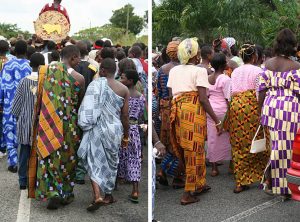
Social changes and modern living have brought about significant changes in how kente is used. It is no longer only the privilege of royalty; anyone who can afford it can buy kente. The old tradition of not cutting the cloth has also long been set aside, and it may be sewn into other forms such as dresses, shirts, or shoes. Printed versions of kente are mass produced and marketed, and both woven and printed versions are used by fashion designers in Ghana and abroad.
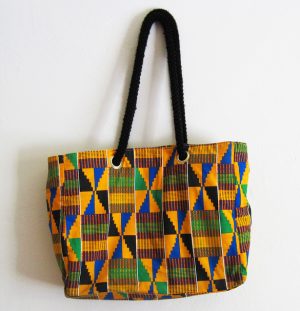
Kente is more than just a cloth. It is an iconic visual representation of the history, philosophy, ethics, oral literature, religious belief, social values, and political thought of West Africa. Kente is exported as one of the key symbols of African heritage and pride in African ancestry throughout the diaspora. In spite of the proliferation of both the hand-woven and machine-printed kente, the design is still regarded as a symbol of social prestige, nobility, and cultural sophistication.
Additional resources:
Videos of kente weaving: Kente Weavers of Asante, Bonwire Kente, Bonwire Kente weavers
“Wrapped in Pride” from the National Museum of African Art
“Asante Textile Arts” from The Metropolitan Museum of Art’s Heilbrunn Timeline of Art History
Memorial Head (Akan peoples)
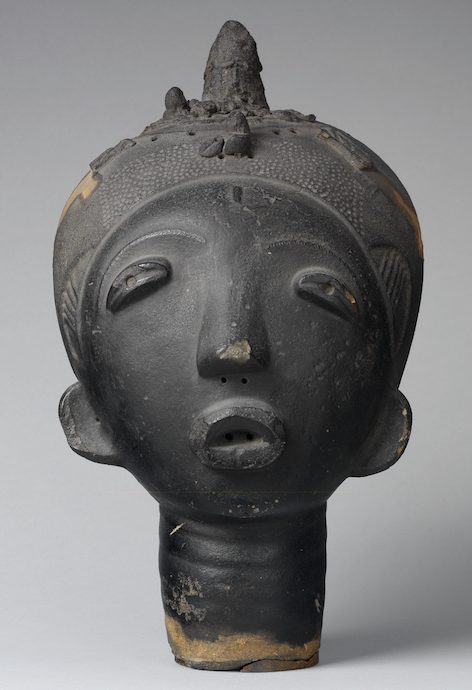
Since the late sixteenth century, Akan women potters have created ceramic heads and sometimes complete figures to commemorate deceased royals and individuals of high status. During the funeral, family members placed the terracotta portraits of the deceased in a sacred grove near the cemetery, sometimes with representations of other family members. These sculptures served as the focal point for funerary rites in which libations and food were offered to the ancestors.
This example has a rounded face with protruding elliptical eyes that tilt downward and a delicately shaped nose. These circular shapes are repeated by the eyebrows, ears, and open, oval-shaped mouth which projects from the smooth surface of the face. An incised line curves around the forehead, indicating the hairline. The surface of the sculpture has been covered with a clay slip tinted black, a color linked to the ancestral world and spiritual power in Akan thought.
Like other examples of African portraiture, these commemorative sculptures are idealized representations that convey individuality through specifics of scarification and hairstyle. The artist would typically be summoned to the deathbed of the deceased in order to observe his or her distinguishing characteristics, which she would depict later, working from memory to capture the individual’s essence. The figural terracotta sculptures vary enormously in style, ranging from fairly naturalistic and sculpturally rounded forms to examples that are solid, flat, and more dramatically stylized.
© 2006 The Metropolitan Museum of Art, New York (by permission)
Additional resources:
This work at The Metropolitan Museum of Art
Ghana on The Metropolitan Museum of Art’s Heilbrunn Timeline of Art History
Smarthistory images for teaching and learning:












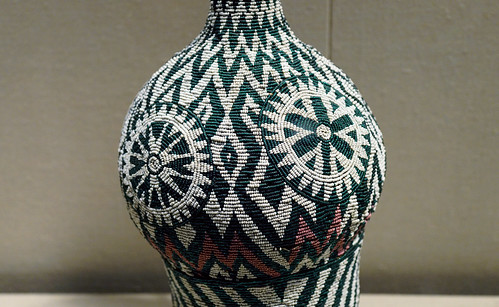
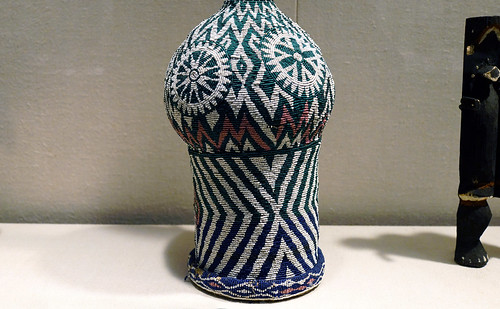
Akua’ba Female Figure (Akan peoples)
by DR. PERI KLEMM
According to Akan myth, in the distant past a woman named Akua could not conceive. Akua sought first the spiritual reason for her infertility. She went to a diviner. He told her to commission a carver to create for her a wooden child and to care for that child as though it were her own. Akua did as she was told and within a few months, she conceived.
Among the Akan peoples, women who had trouble becoming pregnant might utilize one of these figures in the same way Akua did, if a diviner—after ritual prophecy—ascertained that it might be helpful. A carver would then create a figure for her and she would carry it on her back, offer it symbolical food and drink, and honor it on a shrine in her home until she conceived a child (ba). The figure could be gifted to another female family member if she, too, sought spiritual help to bear a child.
Akua’ba figures were important fertility aids among Akan-speakers in Ghana in the past. They depict an abstracted female form in wood and were created by male carvers.
While this figure is called Akua’ba (Akua’s child), it is clearly not meant to resemble a child. Rather, it depicts a highly abstracted and idealized woman in the prime of life (example above left). African art almost always depicts figures in their prime. This time, just after puberty, when young people are generally healthy, strong, initiated, and fertile, is when humans are most ripe with potential—they have the knowledge to successfully pursue adulthood and the physical maturation to marry and procreate. For new parents, this is the stage one hopes for one’s child, especially since high infant and childhood mortality rates remain a formidable reality. The figure is also always female, since Akan culture is matrilineal.
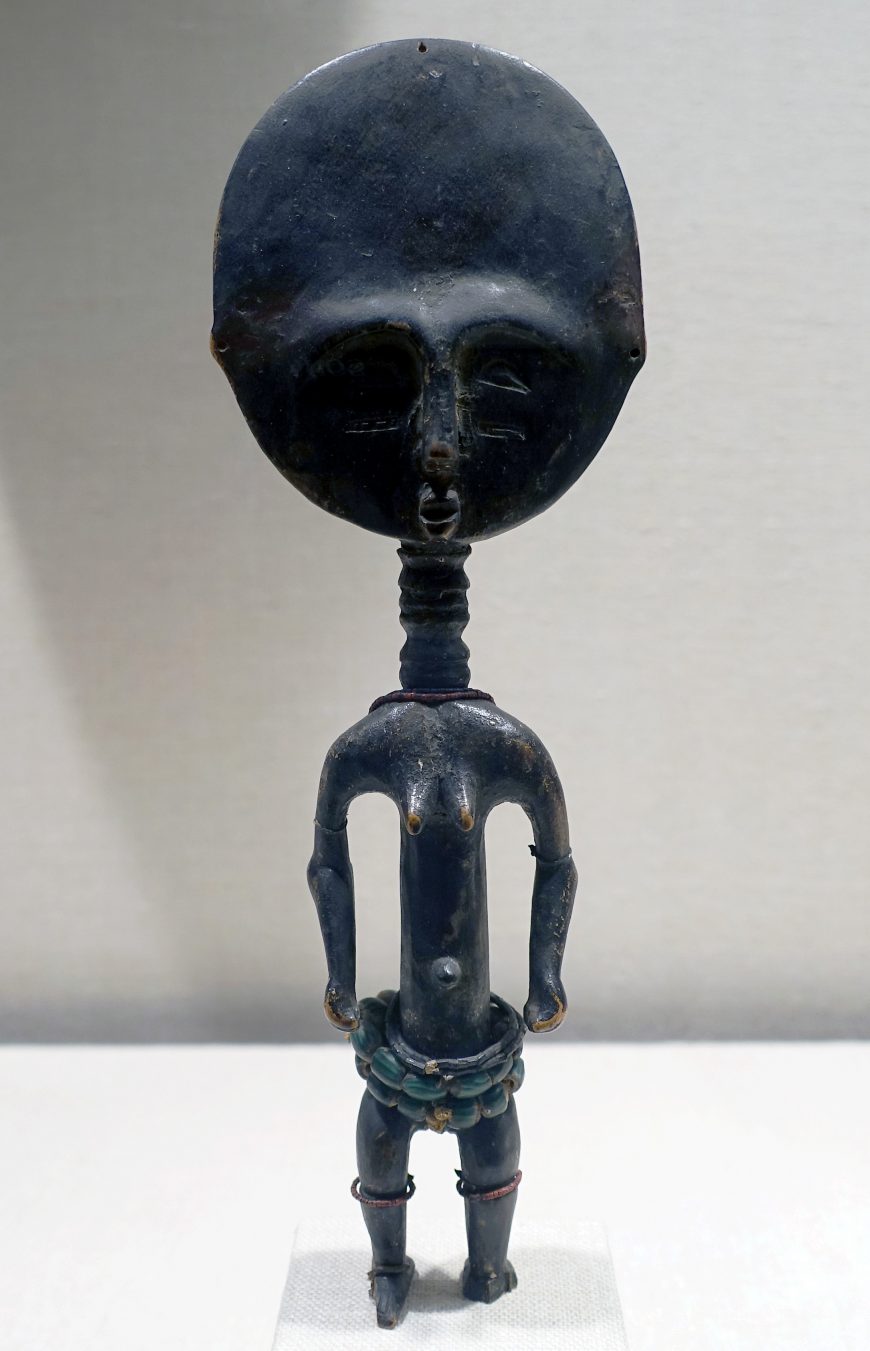
While meant to convey the prime of life, the akua’ba is also quite abstract. Her body has been reduced to a tubular form with small arms, a ringed neck, and a large, flat head. Some akua’ba also have a rectangular head and more recent forms include a more naturalistic body (example right). By emphasizing certain features, the artist has communicated the Akan ideal of female beauty. Her large, rounded forehead, understood as the place where knowledge resides, suggests the wealth of knowledge and intellectual maturity this child should have. Her ringed neck is intended to denote rolls of fat. Extra body fat at this lifecycle state suggests that the young woman is full-figured and capable of baring healthy children. Lastly, her high, protruding breasts suggest a woman who has not yet bore and nursed children. The akua’ba therefore demonstrates three important qualities of womanhood (wisdom, girth, and the prime of life) that relate to her physical and mental abilities.
Due to their unique look and portable size, akua’ba figures have become marketable tourist items and are now part of the Western visual vocabulary. Images of akua’ba have become generalized icons of Africa in commercial settings and it is common to find them depicted in jewelry, greeting cards, print ads and mass media (one is featured on the mantel of the television sitcom Will and Grace). Taken out of the Akan context, altered by Western tastes (which might add beads and paint), and marketed as a universal symbol of Africa, the akua’ba figure is now part of Western popular culture.
Additional resources:
Akua’ba on The Metropolitan Museum of Art’s Heilbrunn Timeline of Art History
Asafo Flags: Stitches Through Time
by HENI TALKS
Gus Casely-Hayford - Asafo Flags: Stitches Through Time from HENI Talks on Vimeo.
Gus Casely-Hayford traces the history of Asafo Flags, unique textiles from Ghana. He draws upon his own personal and historical perspectives to help us understand the lasting relevance of these cultural artefacts.
Featuring national symbols alongside local motifs, Asafo Flags conjure a vibrant past. Whilst flagging familial identity, they also served to signal existing military allegiances with arriving European forces in the 16th century. In ‘a glorious defiance against time’, these flags provide ‘a visual metaphor for what community could mean.’
El Anatsui
El Anatsui, Untitled
by DR. PERI KLEMM and DR. STEVEN ZUCKER
Video \(\PageIndex{2}\): El Anatsui, Untitled, 2009, repurposed printed aluminum, copper, 256.5 × 284.5 × 27.9 cm as installed (Smithsonian National Museum of African Art, Washington D.C.)
The artist transforms metal from alcohol bottles into textiles that represent libations for ancestors.
Smarthistory images for teaching and learning:

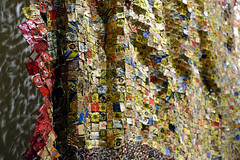
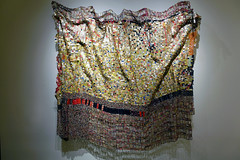
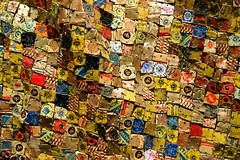
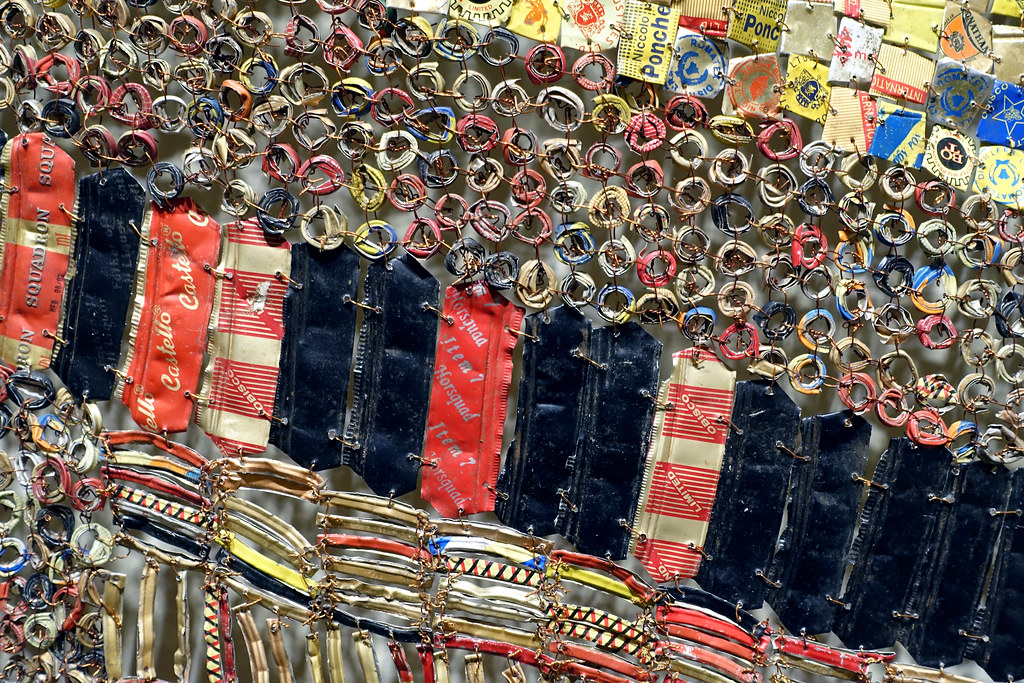
El Anatsui, Old Man’s Cloth
Old Man’s Cloth hangs like a large tapestry, but when we look closer, it’s easy to become captivated by the small metal fragments that comprise the work in hundreds. Arranged within a shifting grid of stripes and blocks of color, the components form their own internal maps across the surface, melding into vertical gold bands, interlocking black and silver rows, or a deviant red piece floating in a field of black. While Old Man’s Cloth would have been laid flat during its construction, it is contorted and manipulated during installation, so that the individual metal pieces can catch the light from every angle. This brilliant visual effect makes its humble origins all the more impressive.

The Medium or the Message?
Old Man’s Cloth has been constructed from flattened liquor bottle labels that the artist collects near his home in Southern Nigeria. While critics often write about Anatsui’s metal wall hangings using the language of textiles, the labels and bottle caps are typically fastened together with copper wire and attached corner-to-corner. As such, the issue of medium is one of the first to inspire debate amongst viewers—are the wall hangings two-dimensional or three-dimensional? Are they sculptures, even as they hang against the wall like paintings? Are they individual works or immersive installations? Lastly, are they “fine art” or simply an innovative form of “craft”?
Purposefully disregarding the limited categories imposed by Western art history, Anatsui’s practice emerges from a more expanded understanding of what art can be that stems from both the radical practices of the late-1960s, and from a vantage point outside of the Western tradition completely. As scholar Susan Vogel has explained, “such categories did not exist in classic African traditions, which made no distinction between art and craft, high art and low.”
Anatsui’s choice of discarded liquor bottle caps as a medium has as much to do with their formal properties as with their historical associations. As an African artist whose career was forged during the utopia of mid-century African independence movements, his work has always engaged his region’s history and culture. The bottle caps, for Anatsui, signify a fraught history of trade between Africa and Europe. As he explained,
Alcohol was one of the commodities brought with [Europeans] to exchange for goods in Africa. Eventually alcohol become one of the items used in the transatlantic slave trade. They made rum in the West Indies, took it to Liverpool, and then it made its way back to Africa. I thought that the bottle caps had a strong reference to the history of Africa.
The luminescent gold colors also recall the colonial past of Anatsui’s home country—modern Ghana was previously a British colony called The Gold Coast until its independence in 1957. The fluid movements of the work’s surface remind us of the waters of the Atlantic Ocean, which carried slave-ships and traders between Africa, Europe and the New World. By bestowing his works with titles such as Man’s Cloth and Woman’s Cloth, Anatsui also makes reference to the significance of textiles in African societies, and their own historical role in trade networks.
Old Man’s Cloth was included in one of Anatsui’s first exhibitions of hanging metal sculptures. Held at London’s October Gallery in 2004, the show was entitled “Gawu,” which means “metal cloak” in Ewe. Old Man’s Cloth is unique for its uneven and jagged edges as well as the “rough texture” of the recycled labels that are incorporated into the piece.
Modernism in Africa
El Anatsui was born in Ghana in 1944, and was trained in an academic European curriculum. In 1964, when he began his studies, many parts of Africa were experiencing a cultural renaissance associated with decolonization movements. Anatsui himself joined the unofficial “Sankofa” movement, which was invested in unearthing and reclaiming Africa’s rich indigenous traditions and assimilating these with the European-influenced aspects of society. His earliest works, for example, included a series of wooden market trays into which he burned designs inspired by African graphic systems and adinkra motifs (symbols widely used by the Akan people of Ghana).
In 1975, Anatsui joined the faculty at the University of Nigeria, Nsukka. Nsukka was a vibrant creative capital for African artists and writers in the 1970s, many of whom spearheaded the Zaria Rebellion in the early 1960s and revived the traditional art form of uli wall and body painting in their contemporary works.
Anatsui’s work differed slightly from that of his colleagues in his insistence on abstraction. In some of his first mature works, he used an electric chainsaw to slash geometric patterns into wood. Though abstract, these works were metaphorically rich; Anatsui chose woods of different colors to represent the diversity of African cultures, while the violence of the chainsaw enacted the ruptures imposed by European imperialist expansion.

Critical Reception: African or Contemporary?
When two of Anatsui’s metal wall hangings appeared in the 2007 Venice Biennale, they were lauded by the public and swiftly cemented his place as a leading international contemporary artist. He had, in fact, already shown in Venice almost two decades earlier in 1990, when he participated in a small exhibition surveying contemporary African art. During the time that lapsed between the two exhibitions, the art world became more receptive to artists outside of its Western centers, and by 2007, Anatsui could exhibit not only as a representative of the continent, but as an individual artist whose work was significant in its own right.
As such, his work provides an excellent opportunity for discussion about the relationships between artists at the center and at the periphery, and between the West and the Global South. The Metropolitan Museum of Art, for instance, has now acquired two of Anatsui’s metal wall hangings, but they are owned by two different curatorial departments: the Arts of Africa, Oceania and the Americas, and Modern and Contemporary Art. Both were recently on view at the same time, but in separate galleries. Visitors, students, and art historians should continue to ask themselves which designation seems more appropriate, and for what reasons. Should we understand his art as a product of its place, its time, or both? What do we see in Anatsui’s work when it is placed among African masks and ritual objects, and how do our impressions change when this work is placed beside contemporary art from around the world?
There are no correct answers to these questions, but they are indicative of the changes that have taken place both in the art world, and in today’s increasingly connected society at large.
Smarthistory images for teaching and learning:



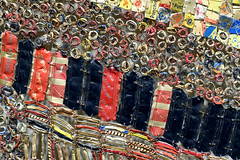
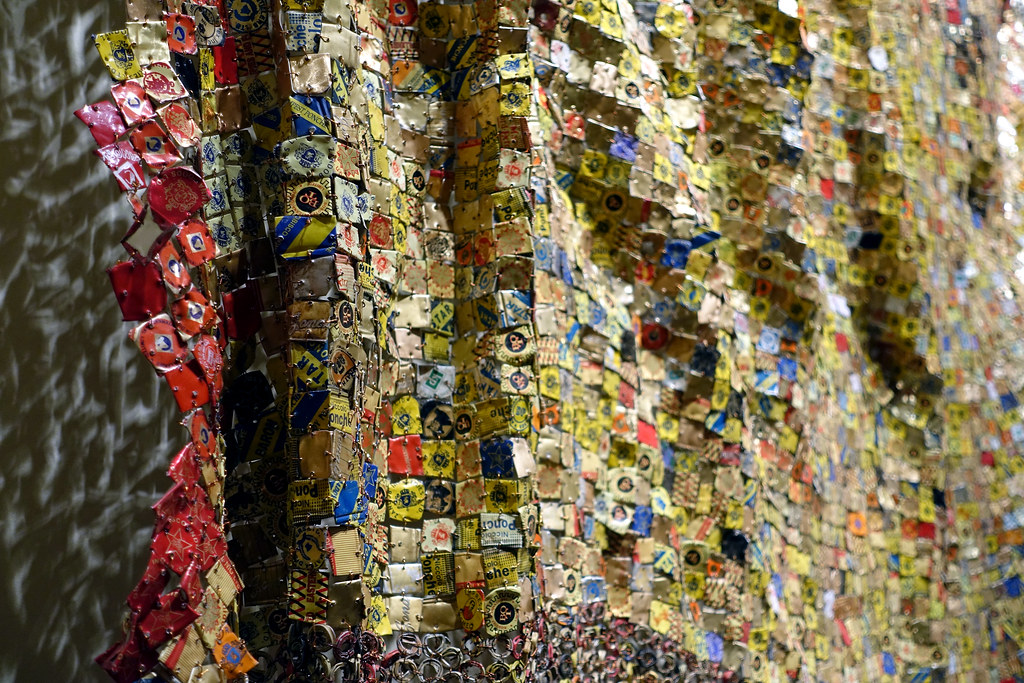
Guinea
Headdress: Female Bust (D’mba)
Video \(\PageIndex{3}\): D’mba mask (Baga peoples, Guinea), 19th-20th century, wood, 118.1 x 35.3 x 67.5 cm (The Metropolitan Museum of Art) Speakers: Dr. Peri Klemm and Dr. Beth Harris
This massive headdress is an example of a regional artistic tradition that dates to at least 1886 and possibly to the early seventeenth century. Among Baga subgroups the headdress is referred to variously as D’mba or Yamban, an abstract concept personifying local ideals of female power, goodness, and social comportment.
Carved from a single piece of wood, this work takes the form of a large head and slender neck supported by a yoke with four projecting legs. Flat, pendulous breasts signify that the subject is a mature woman who has nursed many children. She is distinguished from ordinary Baga by her intricately braided coiffure with high central crest, a hairstyle associated with Fulbe women, who are renowned for their physical beauty. This coiffure is also a reminder of cultural origins, as the Fulbe live in the Futa Jallon mountains, the ancestral homeland of the Baga people.
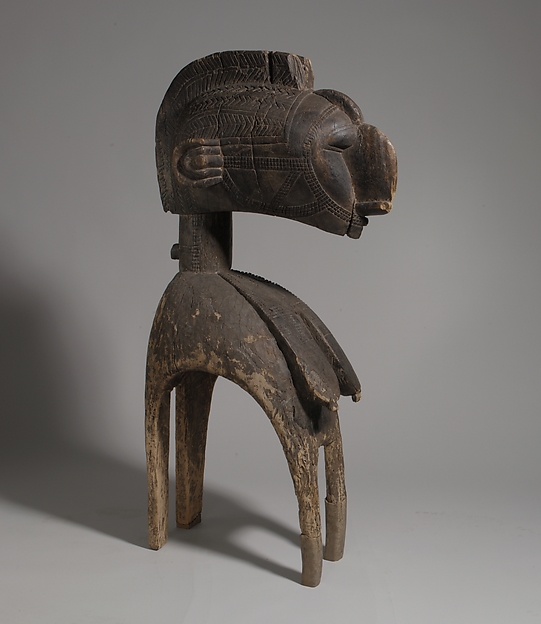
Incised linear patterns representing scarification marks decorate her face, neck, and breasts. Such monumental structures, carried on the shoulders of the performer, often weigh more than eighty pounds. In its original context, the headdress would have had a thick raffia skirt attached to the bottom of the yoke. A shawl of dark cotton cloth, imported from Europe, would be tied around the shoulders, hiding the legs of the yoke.
The ideals of womanhood expressed symbolically by the strong forms of the headdress are reinforced by the movement of the male dancer, who communicates a model of virtuous behavior for Baga women. Performances documented in the 1990s describe the dramatic entrance of the masquerader in a central plaza, preceded by a processional line of drummers. Despite its unwieldy size, the headdress is manipulated skillfully by the dancer, whose movements are alternately composed and vigorous. As the dancer twirls to the accompaniment of drums, the assembled audience of male and female onlookers participates actively. Some reach to touch the breasts of the headdress, affirming its blessings of fertility, while others throw rice, symbolizing agricultural bounty. Songs prescribing proper social behavior are led by women who are joined in the chorus by men. Beginning at sunrise, the celebration continues through sundown and sometimes over the course of many days.

Historically, such masks were used in dances held at planting times and harvest celebrations, as well as at marriages, funerals, and ceremonies in honor of special guests. Following Guinea’s independence from France in 1958 and its adoption of a Marxist government, the tradition was suppressed by Muslim leaders and state officials. In the 1990s, the lifting of decades of censorship was followed by a popular revival of earlier art forms. In Baga society, D’mba (or Yamban) now appears publicly on occasions marking personal and communal growth, including marriages, births, and harvest festivals, as well as celebratory occasions such as soccer tournaments.
© 2006 The Metropolitan Museum of Art, New York (by permission)
The art of the Ivory Coast
To the Baule people, sculpture serves many functions and these can shift over time and within different contexts.
19th - 20th century
Owie Kimou, Portrait Mask (Mblo) of Moya Yanso (Baule peoples)
by DR. PERI KLEMM
The 400,000 Baule who live in central Côte d’Ivoire in West Africa have a rich carving tradition. Many sculpted figures and masks of human form are utilized in personal shrines and in masquerade performances. This mask was part of a secular masquerade in the village of Kami in the early 1900s.
Masquerade
The Baule recognize two types of entertainment masks, Goli and Mblo. To perform a Mblo mask, like the one depicted, a masker in a cloth costume conceals his face with a small, wooden mask and dances for an audience accompanied by drummers, singers, dancers, and orators in a series of skits. In the village of Kami, the Mblo parodies and dances are referred to as Gbagba. When not in use, the Gbagba masks were kept out of sight so it is unusual that we get to see a mask displayed in this manner.
To the Baule, sculpture serves many functions and these can shift over time and within different contexts. The Gbagba masquerade is a form of entertainment no longer practiced in Kami since the 1980s, replaced today by newer masks and performance styles. What is known, however, is that masks like this one were not intended to be hung on a wall and appreciated, first and foremost, for their physical characteristics. Sculpture throughout West Africa has the power to act; to make things happen. A carving of a figure, for example, can be utilized by practitioners to communicate with ancestors and spirits. The physical presence of a mask can allow the invisible world to interact with and influence the visible world of humans. Scholar Susan Vogel mentions that Gbagba could bring social relief at the end of a long day and respite from everyday chores. It allowed residents to socialize, mourn, celebrate, feast, and even, court.[1]
Moya Yanso
In the case of this Gbagba mask, Vogel tells us that it was meant to honor a respected member of Baule society. This mask is unusual. Most older African carving come into Western collections without information about the artist or subject, but in this case, both the carver and the sitter have been recorded. In the photograph below we see an older woman seated next to the portrait mask. She is Moya Yanso and this is her image carved by a well-known Baule artist, Owie Kimou. The man holding the mask is her stepson who danced this mask in a Gbagba performance. It was commissioned and originally worn by Kouame Ziarey, Moya Yanso’s husband and later his sons. Revered as a great dancer, Moya Yanso accompanied the mask in performances throughout her adult life until she was no longer physically able. This portrait mask tradition came to end in the early 1980s with the decline of Gbagba and while entertainment masks continue, they are no longer carved to represent specific individuals.
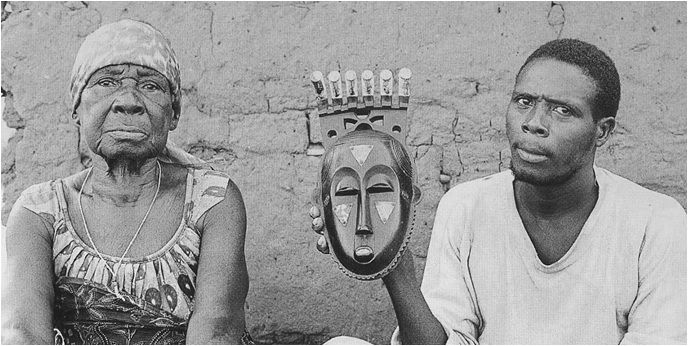
Portrait masks characteristically have an oval face with an elongated nose, small, open mouth, downcast slit eyes with projecting pieces that extend beyond the crest to suggest animal horns. Most also have scarification patterns at the temple and a high gloss patina. These stylistic attributes are actually a visual vocabulary that suggests what it means to be a good, honorable, respected, and beautiful person in Baule society. The half slit eyes and high forehead suggest modesty and wisdom respectively. The nasolabial fold depicted as a line between the sides of the nose to the outsides of the mouth and the beard-like projecting triangular patterns that extends from the bottom of the ears to the chin, suggest age. The triangular brass additions heighten the lustrous patina when danced in the sunlight, a suggestion of health.
An Ideal
The hairstyles of portrait masks are known to be quite realistic but other features, like the six projecting tubular pieces at the crown, are abstract. This is not a realistic representation of the woman in the photograph, rather, it suggests an idealized inner state of beauty and morality associated with Moya Yanso.

Notice that Moya Yanso’s portrait mask is in the hands of her stepson in the photograph. Masking is the prerogative of men. While women attend masquerades as audience members and can perform with masked dancers, they do not wear or own masks themselves. The performers and makers of masks as well as those who commission them are always men.
From West Africa to the Midwest
It is interesting to note the way in which African objects gather value in the West. This mask was acquired from the family of Moya Yanso in 1997 by a collector in Brussels, then sold to a French collector, and finally sold through the Sotheby’s auction house in 1999 for 197,000 US dollars to a collector in Minneapolis. The mask has also been exhibited at the Yale University Art Gallery, the Art Institute of Chicago, and the Museum for African Art in New York. It is featured on the front cover of Baule: African Art, Western Eyes (1997) by Susan Vogel, who has written extensively on Baule art and first conducted fieldwork in Kami village in the 1960s.
For many collectors in the West, it is the formal properties of the mask that are alluring. Like the avant-garde artists in the early 20th century who were looking for new stylistic avenues to represent the modern condition, collectors today value the abstract qualities of Baule art. Vogel aptly notes that “Baule believers first encounter the object’s indwelling spiritual powers, or the metaphysical ideas it evokes, while the connoisseur begins with the visible forms, colors, textures—the artist’s material creation.”[2] Among the Baule up to the 1970s, this mask would remain hidden unless performed with musicians and dancers. To separate this mask from its masquerade is to give it new life as aesthetic object.
[1] Susan M. Vogel, Baule: African Art, Western Eyes, New Haven, 1997, p. 140
[2] Vogel, p. 18
Additional resources
Ravenhill, P. “Likeness and Nearness: The Intentionality of the Head in Baule “Art,“ African Arts, 33(2), 2002.
Susan M. Vogel, Baule: African Art, Western Eyes, New Haven, 1997.
Susan M. Vogel, “Known Artists but Anonymous Works: Fieldwork and Art History”, African Arts, Vol. 31(1), 1999.
Sotheby’s Auction Catalogue
Smarthistory images for teaching and learning:













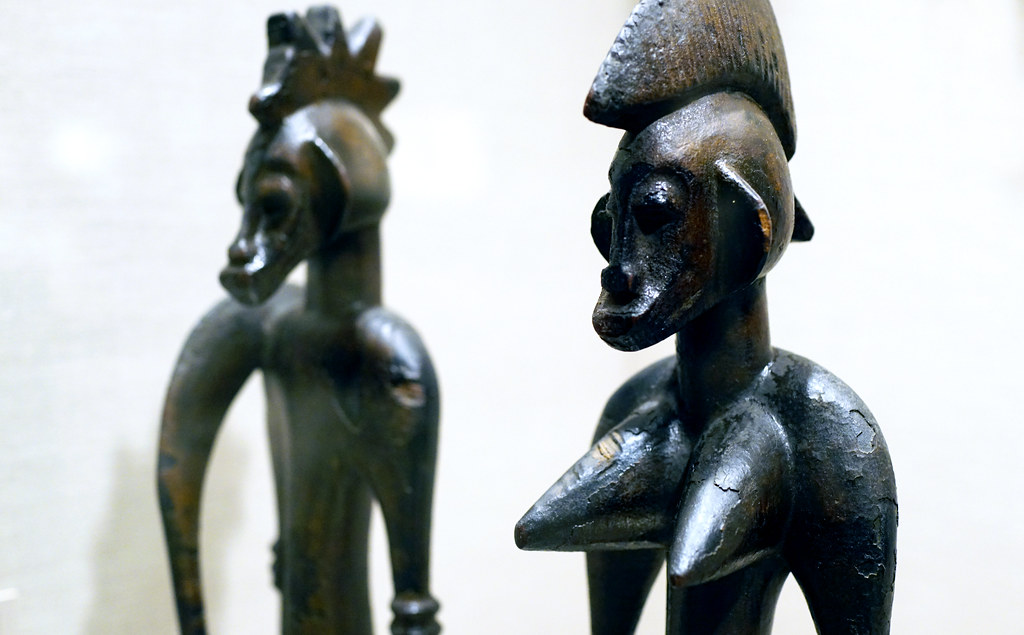
Pair of Diviner’s Figures (Baule peoples)
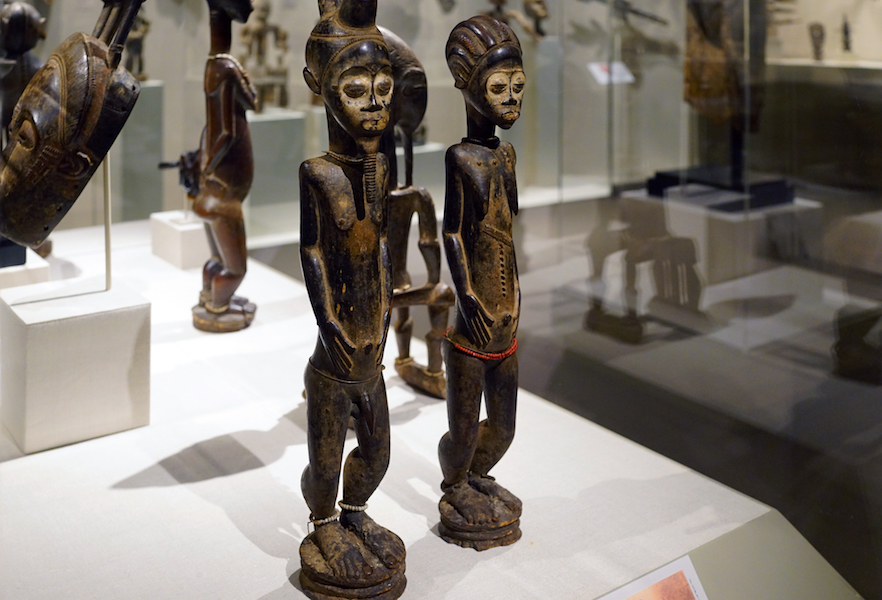
Carved by the same hand, these figures reflect and embody Baule ideals of civilized beauty. In Baule society, diviners commission such figures from artists to attract the attention of asye usu, or nature spirits. Asye usu are considered to be grotesque and volatile beings associated with the untamed elements of nature. The spirits are seduced from the wilderness by the figures’ dazzling beauty and lured into inhabiting the sculptures, which embody the civilized values the asye usu lack and therefore find so desirable. The asye usu are then induced into sharing spiritual insights, conveyed through the medium of the diviner.
Such figures are prominently displayed during ritual sessions with clients who seek clarification about their difficulties, which can range from poor harvests to physical illness. The presence of the sculptures and the sacrificial material applied to their feet (never to the smooth surfaces of their bodies), along with repeated striking of a gong, help to induce the trance state that allows the diviner to communicate with the asye usu. The diviner can then gain insights and revelations regarding the source of the client’s problems. The ownership of such extraordinary works also serves to further the professional standing of the diviner, who must impress potential clients with the caliber and sophistication of the instruments used in his or her practice.
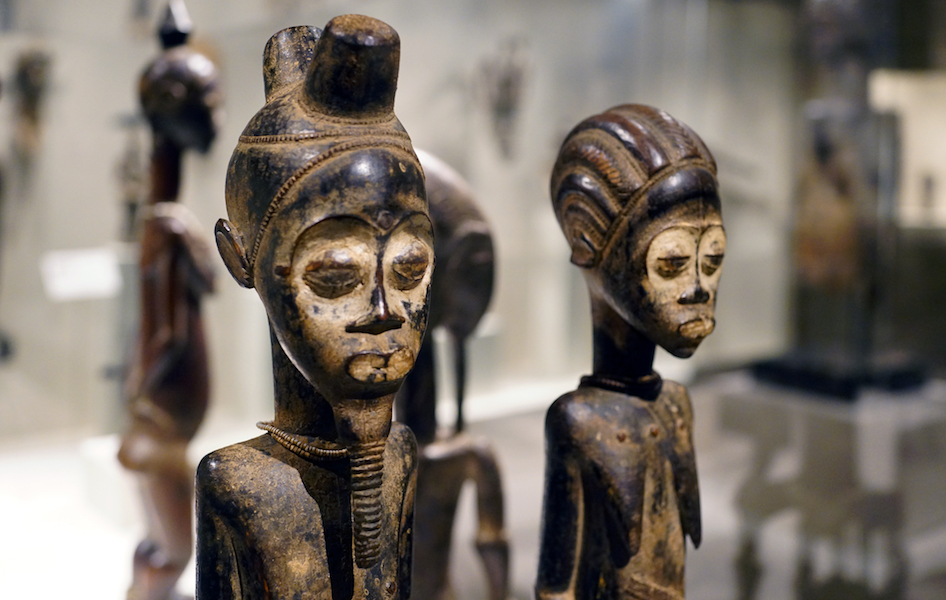
Although depicted separately, the male and female figures are perfectly harmonized through their matched forms, gestures, stances, and expressions. Their elaborate coiffures, intricate scarification, and beaded accoutrements signify cultural refinement and status. Their erect, balanced pose and partially closed eyes imply respect, self-control, and serenity. The fully rounded muscles of their flexed legs suggest physical strength, youthful energy, and the potential for action. White kaolin accentuates the elegant arches of their eyebrows, reflecting the practice of diviners, who apply the fine clay around their eyes to facilitate communication with the spirits.
© 2006 The Metropolitan Museum of Art, New York (by permission)
Additional resources:
Smarthistory images for teaching and learning:












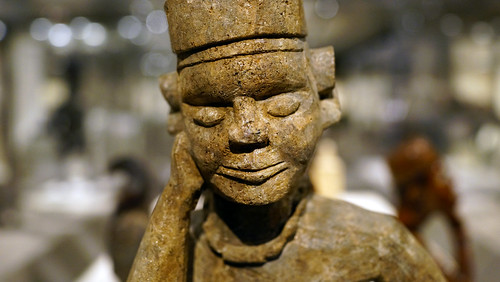
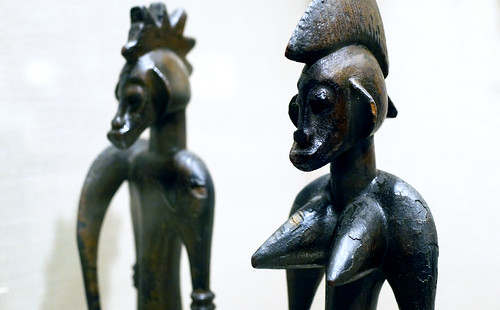
The art of Mali
The art of Mali takes many diverse forms, but it all celebrates the bonds of the communities that create it.
13th century - present
Saving Timbuktu’s manuscripts
by FATHER COLUMBA STEWART, OSB and DR. BETH HARRIS
Video \(\PageIndex{4}\): A conversation with Father Columba Stewart, OSB, executive director of the Hill Museum & Manuscript Library (Collegeville, Minnesota) and Dr. Beth Harris
A heroic effort to save and preserve Mali’s long manuscript tradition.
Seated Figure (Djenné peoples)
Video \(\PageIndex{5}\): Seated Figure, terracotta, 13th century, Mali, Inland Niger Delta region, Djenné peoples, 25/4 x 29.9 cm (The Metropolitan Museum of Art), 82nd & Fifth: “Bundle of Emotions” by Yaëlle Biro.
Among the earliest known examples of art from sub-Saharan Africa are terracotta figures like this one from the inland delta of the Niger River, near the present-day home of the Dogon and Bamana peoples.
In this region of Mali, the ancient city of Jenne-jeno (“Old Jenne”) flourished as a center for agriculture, trade, and art from the middle of the first millennium until about 1600. The terracotta figures associated with this civilization represent men and women, singular and in pairs, in a variety of attire and poses, including sitting, kneeling, and on horseback. The diversity of imagery and the skill with which they were modeled reveal the rich sculptural heritage of a sophisticated urban culture.
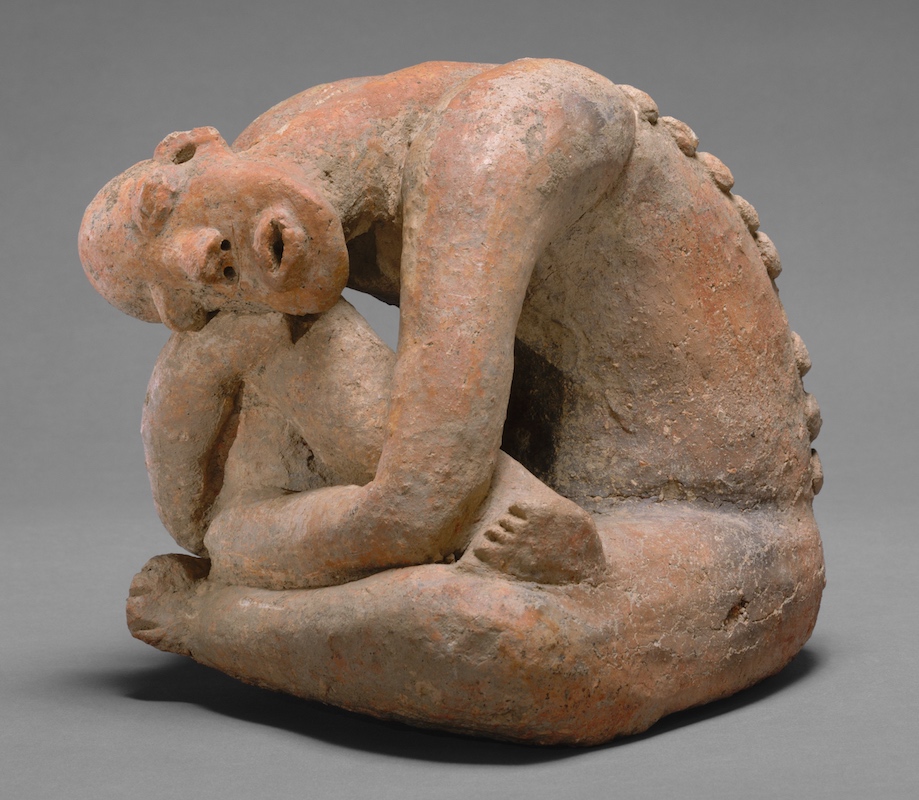
This figure sits, hunched over, with both arms clasping an upraised leg, its head tilted sideways to rest against its bent knee. The posture evokes a pensive attitude that is reinforced by the expressiveness of the facial features: the bulging eyes, large ears, and protruding mouth are all stylistically characteristic of works from this region.
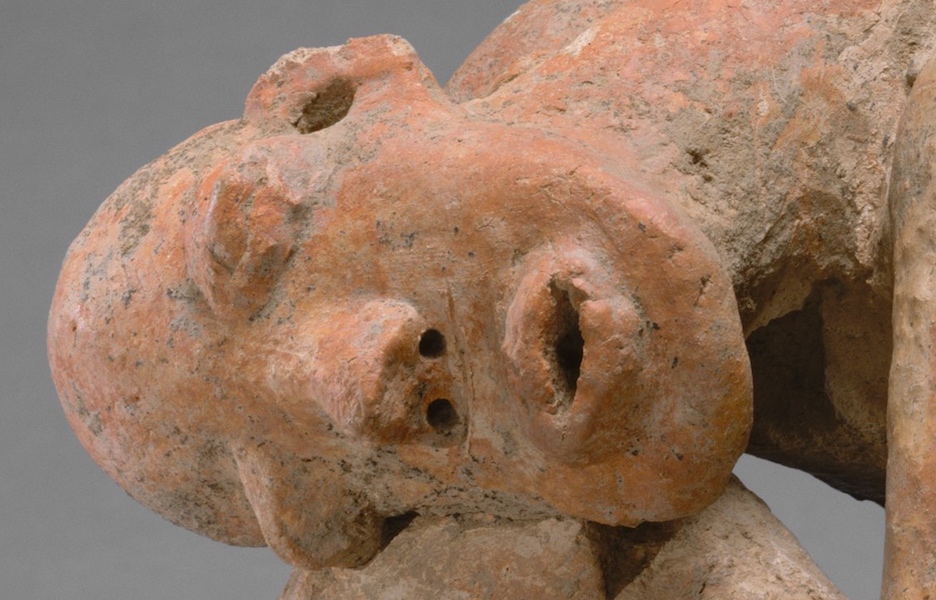
The fluid contours of the body emphasize the long sweeping curve of the neck and back and the rhythmic play of intertwined limbs. Except for the barest suggestion of shoulder blades, fingers, and toes, the figure lacks anatomical details. On the back are three rows of raised marks and two rows of marks punched into the clay. These have been variously interpreted as scarification marks or symptoms of a disease.

Thermoluminescence tests indicate that this figure was fired during the first half of the thirteenth century. Other terracotta figures recovered (and, in many cases, looted) from various sites throughout the Inland Niger Delta have been dated from the thirteenth to the sixteenth century. Artists—either men or women—modeled the figures by hand, using clay mixed with grog (crushed potsherds). Details of dress, jewelry, and body ornament were either added on or incised. Once complete, the work was polished, covered with a reddish-toned clay slip, and then fired, probably in an open-pit kiln.
The surviving figures vary in style and subject matter, suggesting that the sculptors had considerable artistic freedom. Our understanding of the use and meaning of such works remains speculative. A few controlled archaeological digs have revealed similar figures that were originally set into the walls of houses. Oral history collected recently in the region supports the archaeological evidence, as the figures are said to have been venerated in special sanctuaries and private homes. There is little consensus, however, on the meaning of the various forms of the terracotta figures. Scholars have suggested that this figure conveys an attitude of mourning. Its seated pose, shaved head, and lack of dress recall mourning customs still practiced by some in this region of western Africa.
© 2006 The Metropolitan Museum of Art, New York (by permission)
Additional resources:
Explore this object—360 view, from The Metropolitan Museum of Art.
This work at The Metropolitan Museum of Art
Neil Brodie & Donna Yates, “Nok Terracottas” on Trafficking Culture
Holland Cotter, “Imperiled Legacy for African Art,” The New York Times (August 2, 2012)
Smarthistory images for teaching and learning:












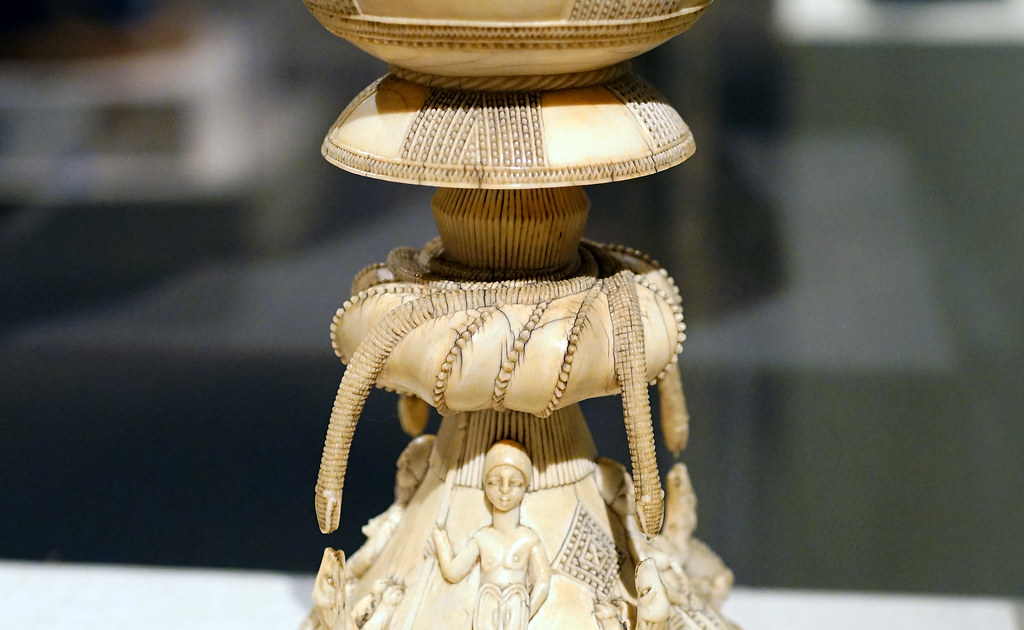
Lost History: the terracotta sculpture of Djenne Djenno
by DR. KRISTINA VAN DYKE and DR. STEVEN ZUCKER
Video \(\PageIndex{6}\): Seated figure, 13th century, Mali, Inland Niger Delta (Djenné peoples), terracotta, 25.4 x 29.9cm (The Metropolitan Museum of Art) Speakers: Dr. Kristina Van Dyke and Dr. Steven Zucker
Are these little-understood figures representations of diseased people, or an attempt to ward off illness?
Additional resources:
This work at The Metropolitan Museum of Art
Djenné on Art and Life in Africa (University of Iowa)
Great Mosque of Djenné (Djenné peoples)

As one of the wonders of Africa, and one of the most unique religious buildings in the world, the Great Mosque of Djenné, in present-day Mali, is also the greatest achievement of Sudano-Sahelian architecture (Sudano-Sahelian refers to the Sudanian and Sahel grassland of West Africa). It is also the largest mud-built structure in the world. We experience its monumentality from afar as it dwarfs the city of Djenné. Imagine arriving at the towering mosque from the neighborhoods of low-rise adobe houses that comprise the city.
Djenné was founded between 800 and 1250 C.E., and it flourished as a great center of commerce, learning, and Islam, which had been practiced from the beginning of the 13th century. Soon thereafter, the Great Mosque became one of the most important buildings in town primarily because it became a political symbol for local residents and for colonial powers like the French who took control of Mali in 1892. Over the centuries, the Great Mosque has become the epicenter of the religious and cultural life of Mali, and the community of Djenné. It is also the site of a unique annual festival called the Crepissage de la Grand Mosquée (Plastering of the Great Mosque).

The Great Mosque that we see today is its third reconstruction, completed in 1907. According to legend, the original Great Mosque was probably erected in the 13th century, when King Koi Konboro—Djenné’s twenty-sixth ruler and its first Muslim sultan (king)—decided to use local materials and traditional design techniques to build a place of Muslim worship in town. King Konboro’s successors and the town’s rulers added two towers to the mosque and surrounded the main building with a wall. The mosque compound continued to expand over the centuries, and by the 16th century, popular accounts claimed half of Djenné’s population could fit in the mosque’s galleries.
The first Great Mosque and its reconstructions
Some of the earliest European writings on the first Great Mosque came from the French explorer René Caillié who wrote in detail about the structure in his travelogue Journal d’un voyage a Temboctou et à Jenné (Journal of a Voyage to Timbuktu and Djenné). Caillié traveled to Djenné in 1827, and he was the only European to see the monument before it fell into ruin. In his travelogue, he wrote that the building was already in bad repair from the lack of upkeep. In the Sahel—the transitional zone between the Sahara and the humid savannas to the south—adobe and mud buildings such as the Great Mosque require periodic and often annual re-plastering. If re-plastering does not occur, the exteriors of the structures melt in the rainy season. Based on Caillié’s description, his visit likely coincided with a period when the mosque had not been re-plastered for several years, and multiple rainy seasons had probably washed away all the plaster and worn the mud-brick.

A second mosque built between 1834 and 1836 replaced the original and damaged building described by Caillié. We can see evidence of this construction in drawings by the French journalist Felix Dubois. In 1896, three years after the French conquest of the city, Dubois published a plan of the mosque based on his survey of the ruins. The structure drawn by Dubois (above) was more compact than the one that is seen today. Based on the drawings, the second construction of the Great Mosque was more massive than the first and defined by its weightiness. It also featured a series of low minaret towers and equidistant pillar supports.
The present and third iteration of the Great Mosque was completed in 1907, and some scholars argue that the French constructed it during their period of occupation of the city starting in 1892. However, no colonial documents support this theory. New scholarship supports the idea that the mason’s guild of Djenné built the current mosque with the help of forced laborers from villages of adjacent regions, brought in by French colonial authorities. To accompany and motivate workers, musicians were provided who played drums and flutes. Workers included masons who mixed tons of mud, sand, rice-husks, and water and formed the bricks that shape the current structure.
The Great Mosque today

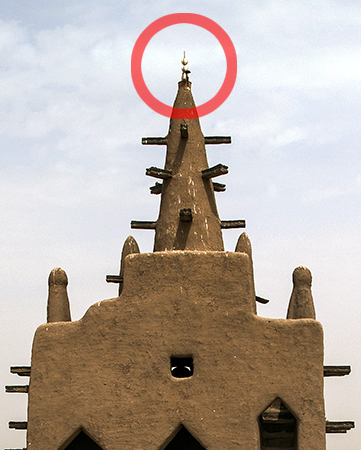
The Great Mosque that we see today is rectilinear in plan and is partly enclosed by an exterior wall. An earthen roof covers the building, which is supported by monumental pillars.
The roof has several holes covered by terra-cotta lids (above), which provide its interior spaces with fresh air even during the hottest days. The façade of the Great Mosque includes three minarets and a series of engaged columns that together create a rhythmic effect (below).
At the top of the pillars are conical extensions with ostrich eggs placed at the very top—symbol of fertility and purity in the Malian region. Timber beams throughout the exterior are both decorative and structural. These elements also function as scaffolding for the re-plastering of the mosque during the annual festival of the Crepissage. Compared to images and descriptions of the previous buildings, the present Great Mosque includes several innovations such as a special court reserved for women and a principal entrance with earthen pillars, that signal the graves of two local religious leaders.

Re-plastering the Mosque

During the annual festival of the Crepissage de la Grand Mosquée, the entire city contributes to the re-plastering of the mosque’s exterior by kneading into it a mud plaster made from a mixture of butter and fine clay from the alluvial soil of the nearby Niger and
Bani Rivers. The men of the community usually take up the task of mixing the construction material. As in the past, musicians entertain them during their labors, while women provide water for the mixture. Elders also contribute through their presence on site, by sitting on terrace walls and giving advice. Mixing work and play, young boys sing, run, and dash everywhere.
Over the years Djenné’s inhabitants have withstood repeated attempts to change the character of their exceptional mosque and the nature of the annual festival. For instance, some have tried to suppress the playing of music during the Crepissage, and foreign Muslim investors have also offered to rebuild the mosque in concrete and tile its current sand floor. Djenné’s community has unrelentingly striven to maintain its cultural heritage and the unique character of the Great Mosque. In 1988, the tenacious effort led to the designation of the site and the entire town of Djenné as a World Heritage Site by UNESCO.
Backstory
The Great Mosque of Djenné is only one of many important monuments in the area known as the Djenné Circle, which also includes the archaeological sites of Djenné-Djeno, Hambarketolo, Tonomba and Kaniana. The region is known especially for its characteristic earthen architecture, which, as noted above, requires continuous upkeep by the local community.
Djenné’s unique form of architecture also makes it particularly susceptible to environmental threats, especially flooding. The town is situated along a river, and in 2016, torrential rains led to massive floods that caused one historic 16th-century palace to collapse, and left the Great Mosque with significant cracks its pillars. Construction of new buildings on the archaeological sites and inadequate waste disposal infrastructure also present continual problems.
UNESCO and other agencies have supported the restoration of the riverbanks in Djenné to help prevent flooding, and the four archaeological sites have now gained official status as properties of the state, which shields them from urban development. However, the conservation situation in Djenné remains fragile. Since the civil war in Northern Mali in 2012, the government has had limited bandwidth to deal with all of the various measures necessary to successfully protect, maintain, and monitor these sites. UNESCO has also noted a lack of funding from outside partners, who, according to the agency, have shown greater interest in Timbuktu, where terrorists vandalized several historic mausoleums and a mosque in 2012.
The current state of Djenné highlights the complex network of factors that affect world heritage: armed conflict and civil unrest, environmental threats, urban development, and lack of cooperation between agencies can all undermine the fate of monuments like the Great Mosque. Such circumstances remind us of the importance and the difficulty of conservation efforts not just in Djenné, but around the globe.
Backstory by Dr. Naraelle Hohensee
Additional Resources:
The website of the Great Mosque of Djenné
Katarina Höije, “The mud mosque of Mali” from Roads and Kingdoms (May 2018)
Old Towns of Djenné (from UNESCO)
UNESCO State of Conservation report for the Old Towns of Djenné
Dogon Couple (Dogon peoples)
by STEVEN ZUCKER and DR. PERI KLEMM
Video \(\PageIndex{7}\): Dogon Couple, 18th-early 19th century (Dogon peoples), Mali, wood and metal, 73 x 23.7 (The Metropolitan Museum of Art)
Speakers: Dr. Peri Klemm and Dr. Steven Zucker
Is this a couple, or could this pair relate to a story from Dogon cosmology?
Smarthistory images for teaching and learning:

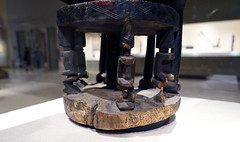


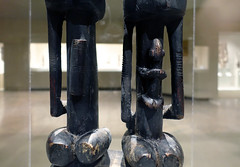
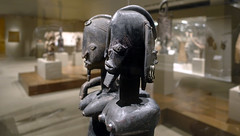
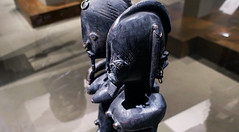
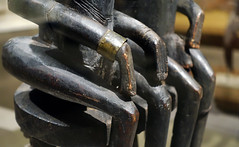
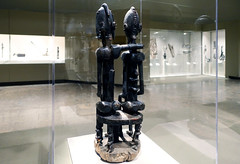

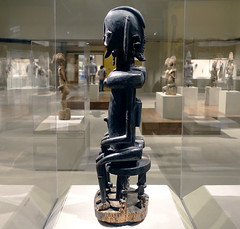

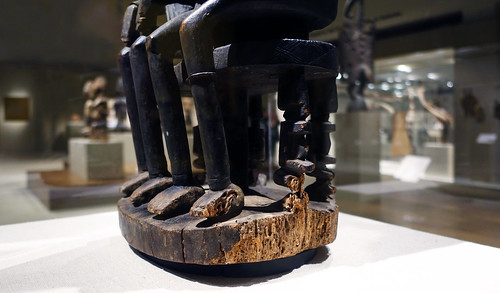
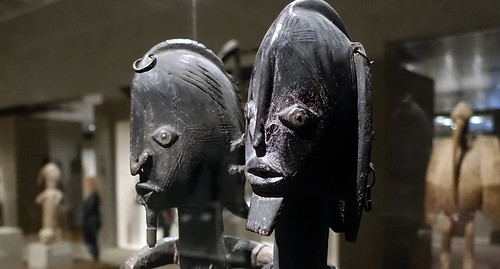
Mask (Kanaga) (Dogon peoples)
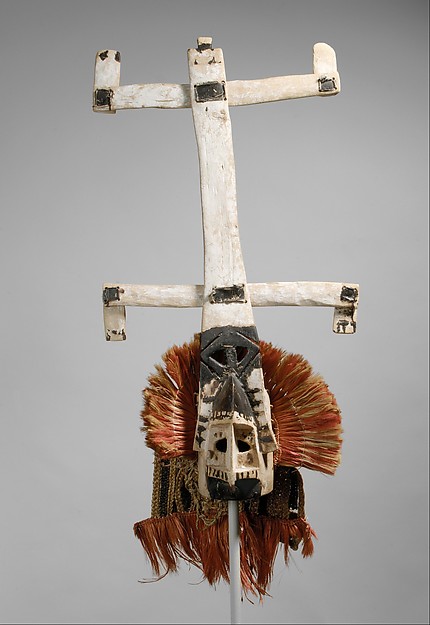
Dogon masks, such as this one called kanaga, are worn primarily at dama, a collective funerary rite for Dogon men. The ritual’s goal is to ensure the safe passage of the spirits of the deceased to the world of the ancestors. The ceremony is organized by members of Awa, a male initiation society with ritual and political roles within Dogon society. As part of the public rites related to death and remembrance, Awa society members are responsible for the creation and performance of the masks.
Like other Dogon wooden masks, kanaga masks depict the face as a rectangular box with deeply hollowed channels for the eyes. The superstructure above the face identifies this mask as a kanaga: a double-barred cross with short vertical elements projecting from the ends of the horizontal bars. This abstract form has been interpreted on two levels: literally, as a representation of a bird, and, on a more esoteric level, as a symbol of the creative force of god and the arrangement of the universe. In the latter interpretation, the upper crossbar represents the sky and the lower one, the earth.
This kanaga mask was collected complete with some of its costume elements. Attached to the wooden face mask is a hood composed of plaited fiber strips dyed black and yellow with a short fiber fringe that covers the dancer’s head. A ruff of red and yellow fibers frames the face. The dancer also wore a black vest woven of fiber and embroidered with white cowry shells and fiber armbands at the wrists and elbows. This ensemble included a long skirt of loosely strung, curly black fibers and a short overskirt composed of straight red and yellow fibers, worn over trousers.
More than eighty different types of masks, of both wood and fiber, have been documented in dama performances. They represent various human characters familiar to the Dogon community, such as hunters, warriors, healers, women, and people from neighboring ethnic groups. The masks may also depict animals, birds, objects, and abstract concepts.
Because preparations are elaborate and costly, the dama may be held several years after the death and burial of an individual. Performances take place over a six-day period, culminating with a procession of masked dancers who escort the souls of the dead from the village, where they might cause harm, to their final resting place in the spiritual realm. The ceremony recalls the origins of the Dogon people, while also marking the end of the mourning period for the recently deceased. Today, such masks continue to be worn at dama performances but are also danced on other, more secular occasions, such as national holidays and as demonstrations organized for the benefit of tourists.
© 2006 The Metropolitan Museum of Art, New York (by permission)
Additional resources:
This work at The Metropolitan Museum of Art
Dogon art at The Metropolitan Museum of Art
Dogon peoples from Art and Life in Africa (University of Iowa)
Smarthistory images for teaching and learning:














Male and Female Antelope Headdresses (Ci wara) (Bamana peoples)
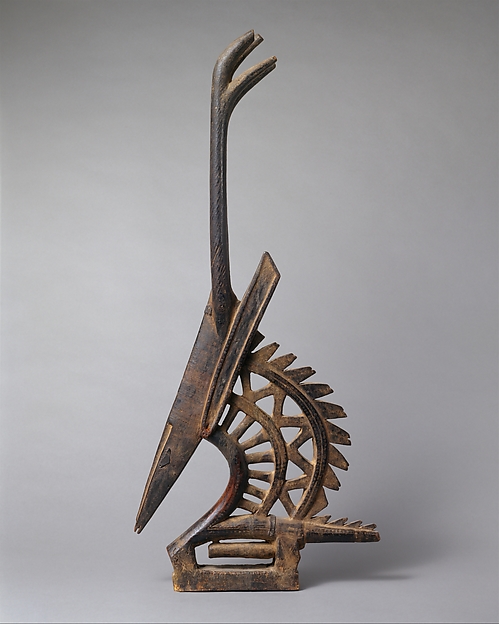
Pairs of carved wooden headdresses in the form of antelopes, like these examples, refer to the mythic culture hero Ci Wara, a divine force conceived of as half man and half antelope. Bamana oral traditions credit Ci Wara with introducing to humanity agricultural methods and an understanding of earth, animals, and plants. In the nineteenth and early twentieth centuries, Ci Wara was invoked and honored by members of a men’s agricultural association, also called ci wara, in village-wide performances that celebrated the skills of successful farmers. These performances featured a pair of dancers wearing sculpted headdresses, one representing a male antelope and the other a female. They held sticks in their hands to paw the earth just as the mythic Ci Wara did when he first taught men to plant seeds.
In performance, the paired dancers symbolize the union between men and women, essential for the continuity of the community. The formal features of the headdress also reference elements of nature necessary to sustain life. The male serves as a metaphor for the sun, while the female is associated with the earth. The long strands of raffia fibers attached to the headdress, concealing the dancer, are likened to streams of water.
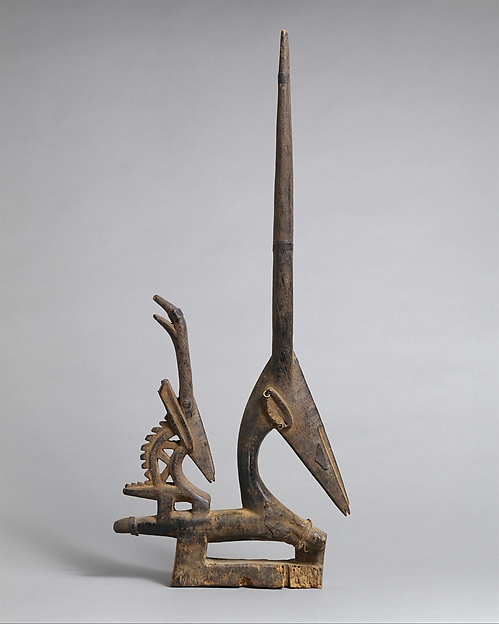
Although ci wara headdresses are generally described as representing antelopes, they incorporate features of other animals, including aardvarks and pangolins. These animals are selected for their symbolic value. In this pair, the horns and long, arched neck represent the antelope, associated with grace and strength. The head with a long, pointed nose and the low-slung body are features of the aardvark, admired for its determination in digging. The sculpted headdress is attached to a basketry skullcap (now missing on these examples) and secured on top of the dancer’s head with a cotton strip. The dancer’s face would be covered by a semitransparent cloth, and a costume of darkened raffia fiber would cloak the dancer’s body.
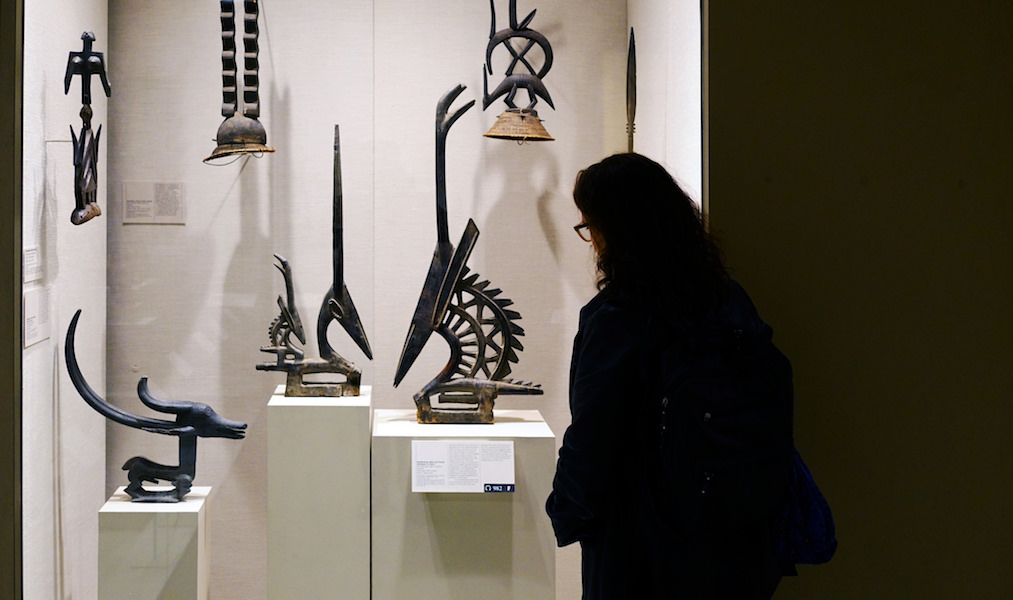
The silhouette-like nature of sculptural representation is noted for its elegant play of positive and negative space. The male, identified as a roan antelope, is distinguished by its long horns and elaborate openwork mane. The female, representing an oryx antelope, carries a fawn on her back, a reference to human mothers, who carry babies on their backs as they till the fields. The face and horns of both are decorated with delicate chip-carved patterning, incised linear designs, and metal appliqué and strips.
The Bamana, who live in the southern part of present-day Mali, have long considered farming to be among the most noble of all professions. Traditionally, Bamana farmers have worked arduously in the savanna fields from May to October, when it rains regularly, in order to provide enough food during the long, dry season. Today, despite the significant social changes that have impacted contemporary Bamana experience, farming remains central to their identity. Although many Bamana have adopted Islam over the course of the last century, theatrical ci wara dances continue in many Bamana villages, celebrating their agrarian lifestyle. Among the continent’s most well-known forms of expression, the elegantly abstract form of the ci wara headdress has also been adopted as a national symbol of cultural identity, used as a logo by Mali’s official airline and found on the national currency.
© 2006 The Metropolitan Museum of Art, New York (by permission)
Video \(\PageIndex{8}\): The Artist Project: Willie Cole (from The Metropolitan Museum of Art). Willie Cole, born in 1955, is an American sculptor who lives and works in New Jersey. See an example of his work here.
Additional resources:
This work at The Metropolitan Museum of Art
Bamana art from The Metropolitan Museum of Art
Ci Wara on The Metropolitan Museum of Art’s Heilbrunn Timeline of Art History
Bamana peoples on Art and Life in Africa (University of Iowa)
Genesis: Ideas of Origin in African Sculpture (Met publication)
Smarthistory images for teaching and learning:













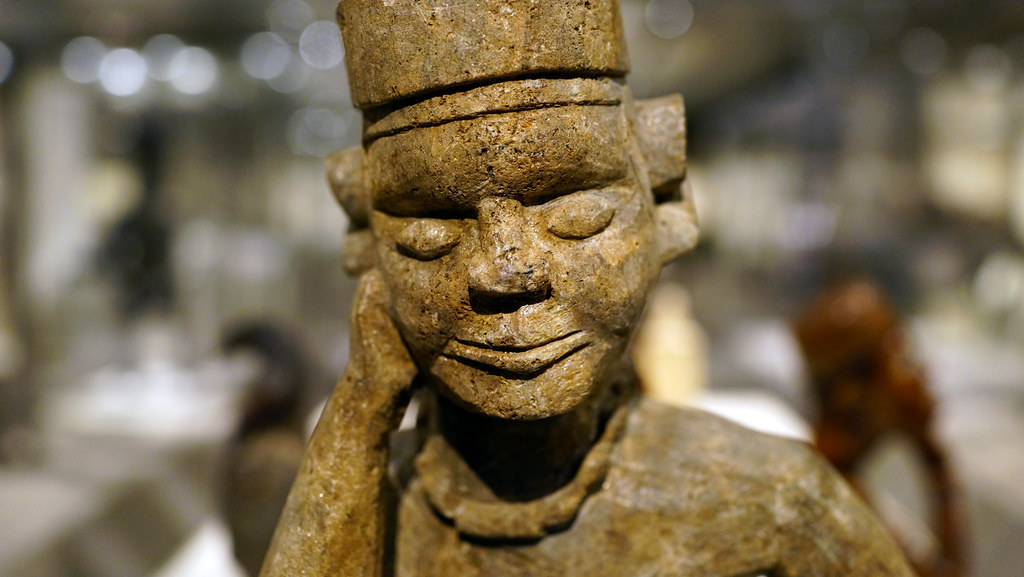
Kòmò Helmet Mask (Kòmòkunw) (Bamana peoples)
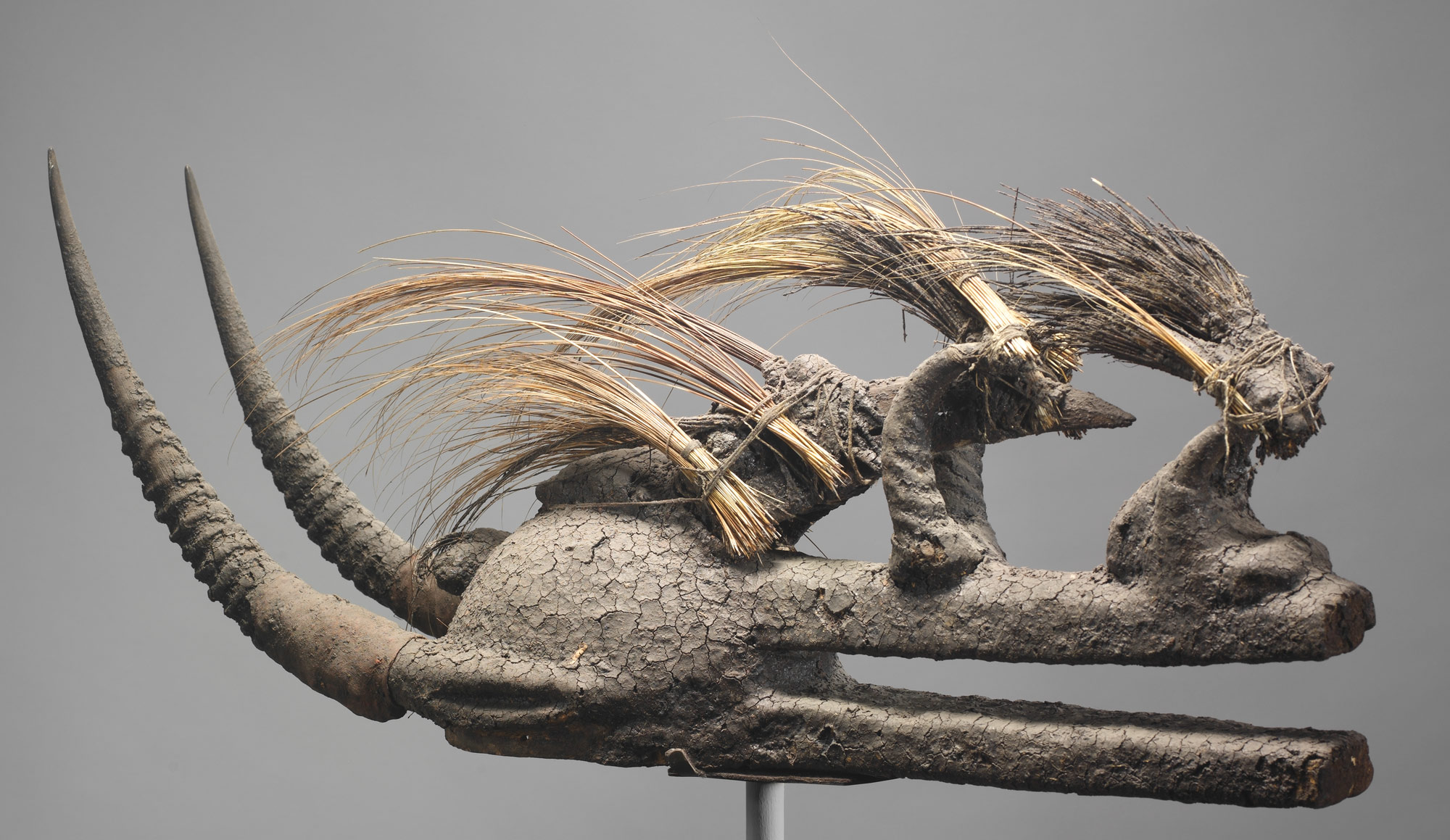
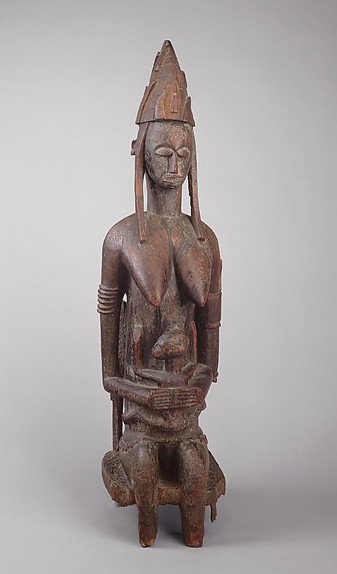
This headdress (above) was made and used by a member of the Komo society, an association of blacksmiths found among the Bamana and other Mande-speaking communities in the region. Komo association members enforce community laws, make judicial decisions, and offer protection from illness, misfortune, and malevolent forces. The headdress embodies the secret knowledge and awesome power of the society; its rough and unattractive form is therefore intended to be visually intimidating. While works like the Bamana maternity figure (left) depict a human ideal, this headdress is explicitly about harnessing the forces of untamed nature, a concept expressed visually in its form and material.
The wooden structure of the headdress has a domed head, gaping mouth, and long horns. Attached are antelope horns, a bird skull with a sharp beak, and porcupine quills, elements chosen for their metaphorical associations since they provide animals with power and protection. The animals themselves hold symbolic value in Bamana culture. Birds, for example, are associated with wisdom and divinatory powers, while porcupines signify the importance of preserving knowledge. The mask was further enhanced by the application of ritual substances formed from a mixture of earth, sacrificial animal blood, and medicinal plants. This material was replenished on a regular basis, endowing the mask with the critical life force, or nyama, that is the source of its extraordinary power.
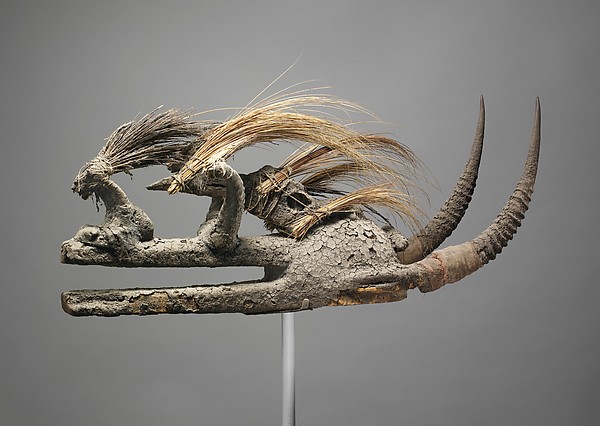
Komo society headdresses are made by blacksmiths, a specialized artisan group among the Bamana whose profession is inherited. Blacksmiths are greatly respected within their community for the special knowledge and technical skills that allow them to use fire, water, and air to transform iron ore into tools and weapons. Ironworking is considered an especially dangerous profession, one that requires courage and extraordinary abilities to manage the potentially destructive spiritual forces released during the process. Blacksmiths are therefore uniquely qualified to create Komo headdresses, which combine terrifying forms and inherently harmful materials in an object of benefit to the community.
The headdress is worn in dramatic performances that serve as a focal point of Komo society meetings. Held in private and restricted to initiated members, these meetings provide an opportunity to gain an understanding of the society’s history, beliefs, and rituals. Accompanied by bards and musicians, a high-ranking Komo member appears wearing a headdress like this strapped on the top of his head. His face is covered with a semitransparent cloth and he wears a costume of black feathers enhanced with amulets over a hooped skirt. The dancer’s performance is acrobatic and intense, featuring spectacular feats that suggest extraordinary powers. His performance responds to petitions for assistance from members of the community. Through song and dance, the Komo member gradually reveals solutions to a variety of concerns that have been presented to him, from crop failure to infertility.
Considered the most powerful of men’s associations in the region, Komo has an ancient history and was well established by the time the Mali empire rose to power in the thirteenth century. Individual community branches of Komo, which are distributed widely across the region, gain authority through strong leadership, coalitions with wilderness spirits, and effective use of power objects.
© 2006 The Metropolitan Museum of Art, New York (by permission)
Seydou Keïta, Untitled (Seated Woman with Chevron Print Dress)
![Seydou Keïta, Untitled [Seated Woman with Chevron Print Dress], 1956, printed 1997, Mali, Bamako, gelatin silver print, 60.96 x 50.8 cm (The Metropolitan Museum of Art)](https://smarthistory.org/wp-content/uploads/2016/10/hb_1997-364.jpg)
Commercial studio portrait photography was introduced in Mali in the 1930s and developed into a thriving industry in Bamako, the capital city, during the postwar period. Bamako’s rapid economic development and accompanying population boom fueled demand for photographic portraits. Such photographs were commissioned by members of the growing middle class as mementos to be displayed on the walls of their homes or sent to faraway family members.
Among the busiest portrait studios in Bamako was that of photographer Seydou Keïta. Born in 1923, Keïta originally apprenticed as a carpenter but found his vocational calling when he was given a 6 x 9 Kodak Brownie camera by his uncle. After experimenting on his own, Keïta learned darkroom techniques from two established commercial photographers. He opened his own studio in 1948 in Bamako-Koura, an area of the city whose proximity to a train station and popular marketplace ensured a steady stream of potential clients.
Keïta soon became highly successful as a commercial photographer, producing tens of thousands of portraits over the course of his career. He developed a consistent and recognizable signature style that proved popular with local clients, who requested that their prints include a stamp with Keïta’s name. A typical sitting took place during the day in his outside courtyard and could last up to an hour. Keïta gave his sitters the opportunity to individualize their portraits, helping them select a flattering pose and offering a variety of accessories as props. He posed his clients against a printed cloth, which often resulted in vibrant juxtapositions between the patterns of the sitter’s clothes and that of the backdrop. Other compositional strategies included the use of a shallow depth of field and an emphasis on repetition and symmetry in framing his subject.
In this portrait, a woman reclines on her side with a relaxed and self-possessed dignity. The tight cropping places the focus entirely on the sitter, while the camera angle makes her appear on a slightly tilted slope, creating a symmetrical composition. The floral print of the woman’s boubou (a traditional form of dress) contrasts with the bold black and white checkered blanket in the foreground and the swirling arabesques of the cloth backdrop, creating a syncopated clash of patterns and rhythms. Her dress and pose communicate significant aspects of her identity, revealing how traditional concepts of portraiture are maintained and modified through the medium of photography. Her head wrap is worn in a trendy style called “à la Gaulle,” its jaunty angle framing the scarification marks of ethnic affiliation that she bears on her forehead. She rests her left arm casually at her waist, dangling her long slender fingers, which are considered a sign of high social standing.
When Mali won independence from France in 1962, Keïta was offered a position as official government photographer, where he remained until 1977. His governmental responsibilities required him to close his studio in 1964 and he never reopened his portrait practice, although he did continue his photography. Beginning in the 1990s, Keïta’s work was included in several exhibitions in the United States and Europe, bringing him considerable fame in the international art world.
© 2006 The Metropolitan Museum of Art, New York (by permission)
The art of Nigeria
From the Kingdom of Benin to the arts of the Yoruba, Nigeria is home to ancient and vibrant art traditions.
c. 15th century - present
Benin Plaques
by DR. KATHRYN WYSOCKI GUNSCH and DR. BETH HARRIS
How to impress your courtiers: a lesson from the Kingdom of Benin
Additional resources
Benin plaques at the MFA, Boston
Kathryn Wysocki Gunsch, The Benin Plaques A 16th Century Imperial Monument, Oxford: Routledge, 2018
The Kingdom of Benin
Until the late 19th century, one of the major powers in West Africa was the kingdom of Benin, in what is now southwest Nigeria. When European merchant ships began to visit West Africa from the 15th century onwards, Benin came to control the trade between the inland peoples and the Europeans on the coast. The kingdom of Benin was also well known to European traders and merchants during the 16th and 17th centuries, when it became wealthy partly due to the slave trade.
A vivid picture

When the British tried to expand their own trade in the 19th century, the Benin people killed their envoys. So in 1897, the British sent an armed expedition which captured the king of Benin, destroyed his palace and took away large quantities of sculpture and regalia, including works in wood, ivory and especially brass. Some of these objects came from royal altars for the king’s ancestors, but among them were a large number of cast brass plaques made to decorate the wooden pillars of the palace. These had been left in the palace storerooms while part of the palace was being rebuilt. As it later emerged, most of them were probably made between about 1550 – 1650. The people and scenes that the plaques depict are so many and varied that they give a vivid picture of the court and kingdom of that time. The plaques were most sought after and were bought by museums across Europe and America—you can see them at the British Museum, in Chicago, Vienna, Paris and a large collection can be viewed in Berlin.
A sensation
The arrival and reception of the bronze plaques caused a sensation in Europe. Scholars struggled to understand how African craftsmen could have made such works of art, proposing some wild theories to explain them. Quickly, however, research showed that the Benin bronzes were entirely West African creations without European influence, and they transformed European understanding of African history.
The plaques
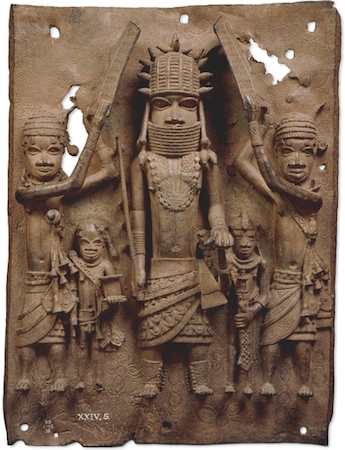
When the son of the deposed king revived the Benin monarchy in 1914, now under British rule, he did his best to restore the palace and continue the ancient traditions of the Benin monarchy. Because these traditions are followed in the modern city of Benin, it is still possible to recognize many of the scenes cast in brass by Benin artists about five hundred years ago.
As decorations for the halls of the king’s palace, the plaques were designed to proclaim and glorify the prestige, status, and achievements of the king, so they give an informative but very one-sided view of the kingdom of Benin. They do not show how the ordinary people lived in the villages outside the city as farmers, growing their yams and vegetables in gardens cleared from the tropical forest. Nor do they show how most of the townspeople lived, employed in crafts such as the making of the brass plaques themselves. And most striking of all, there are no women or children shown in the plaques, which means that more than half of the people of the king’s court are not shown.
Many of the brass plaques from the king’s palace show images of Portuguese men, whose costumes indicate that they were made during the 16th and 17th centuries. Although Benin had no gold to offer, they supplied the Portuguese with pepper, ivory, leopard skins and people, who were taken as slaves to work elsewhere in Africa and in the Portuguese colonies in Brazil. Many of these people were captives taken in the wars in which the Benin people conquered their neighbours far and wide and made them part of the kingdom, or they were sent by the conquered local chiefs as tribute to the king.
© Trustees of the British Museum
Benin Art: Patrons, Artists and Current Controversies
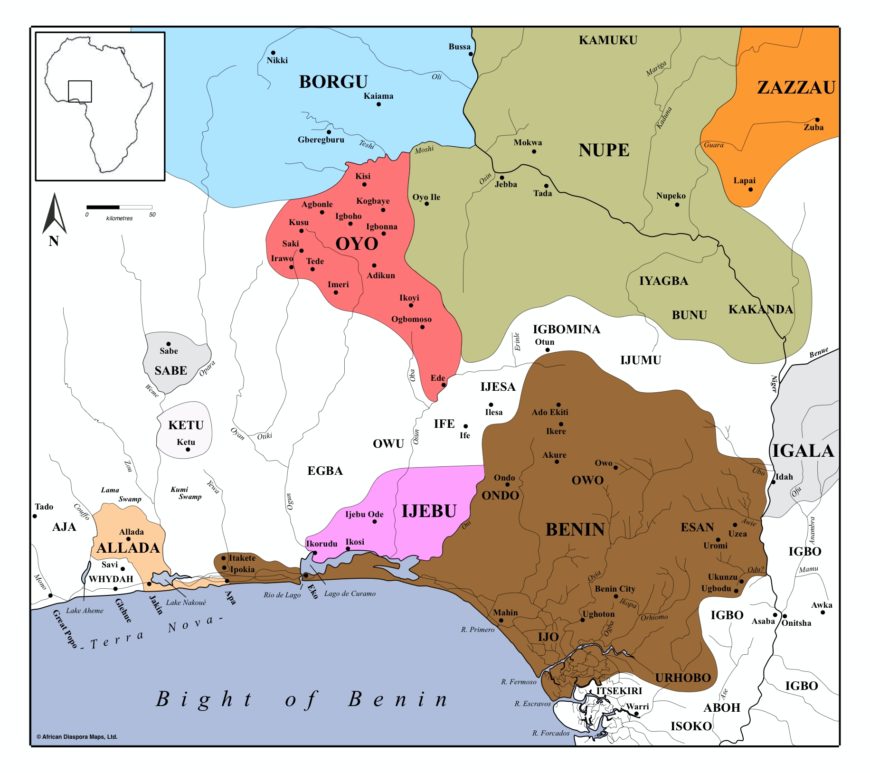
In the age of social media, nearly everyone can present an idealized version of their real lives to the world. In the past, however, only the wealthiest and most powerful could afford to shape their image for the public. During the sixteenth century, the kings of Benin (in present-day Nigeria), reigned over nearly two million subjects and commanded a feared military force, but they also faced internal political problems that threatened the throne.
Politics, power, and art
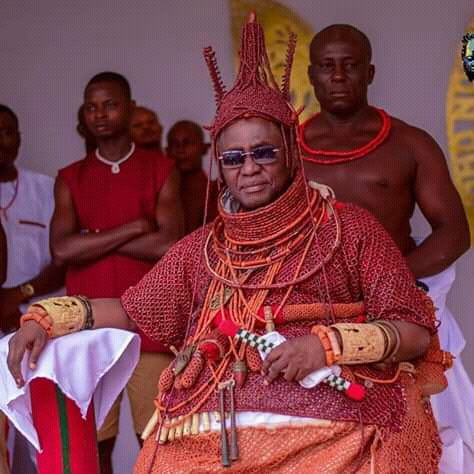
The Kingdom of Benin was founded around the year 900, but it reached the height of its power in the fifteenth and sixteenth centuries as a result of the conquests of new territories by two kings —Oba Ewuare and his son Oba Ozolua (Oba means “king”).
The Obas of Benin amassed great wealth by controlling trade routes reaching from the river Niger in the East to the western border with the kingdom of Dahomey. Taxes on pepper, ivory, and enslaved persons, and annual tribute payments from conquered lands in their expanding empire, also increased the wealth of the Kingdom.
Royal art from this period (and from a slightly later time of renewed wealth and power in the eighteenth century), was designed to broadcast and strengthen dynastic power. Benin court art celebrates the prestige of the monarchy to outsiders (like traders and ambassadors), as well as to courtiers who might try to wrest power from the king.
In the early sixteenth century, Oba Esigie successfully consolidated Benin’s power over conquered territories. He took the throne after a civil war with his older brother and soon after defended Benin City from an attack from a neighboring kingdom (Idah). His commissions were designed to address the turmoil of his early reign. Esigie was a brilliant politician, and he commissioned great works of art and new festivals to assert the legitimacy of his reign.
The festival of Ugie Oro
Esigie instituted the festival of Ugie Oro, where high-ranking courtiers process around Benin City striking bronze staffs with a bird on top. The festival refers to the Idah war, when leading courtiers refused to support Esigie in his defense of the city. A bird in a tree en route to the battle prophesied that Esigie and his troops would be defeated. Esigie shot the bird and carried it as his battle standard. When he won the war against the Idah, he instituted the festival to point out that the advice of the courtiers—and the bird—had been nothing more than the empty noise produced by clanging the bronze staffs, pointing out that courtiers’ should defer to the wisdom of the king.
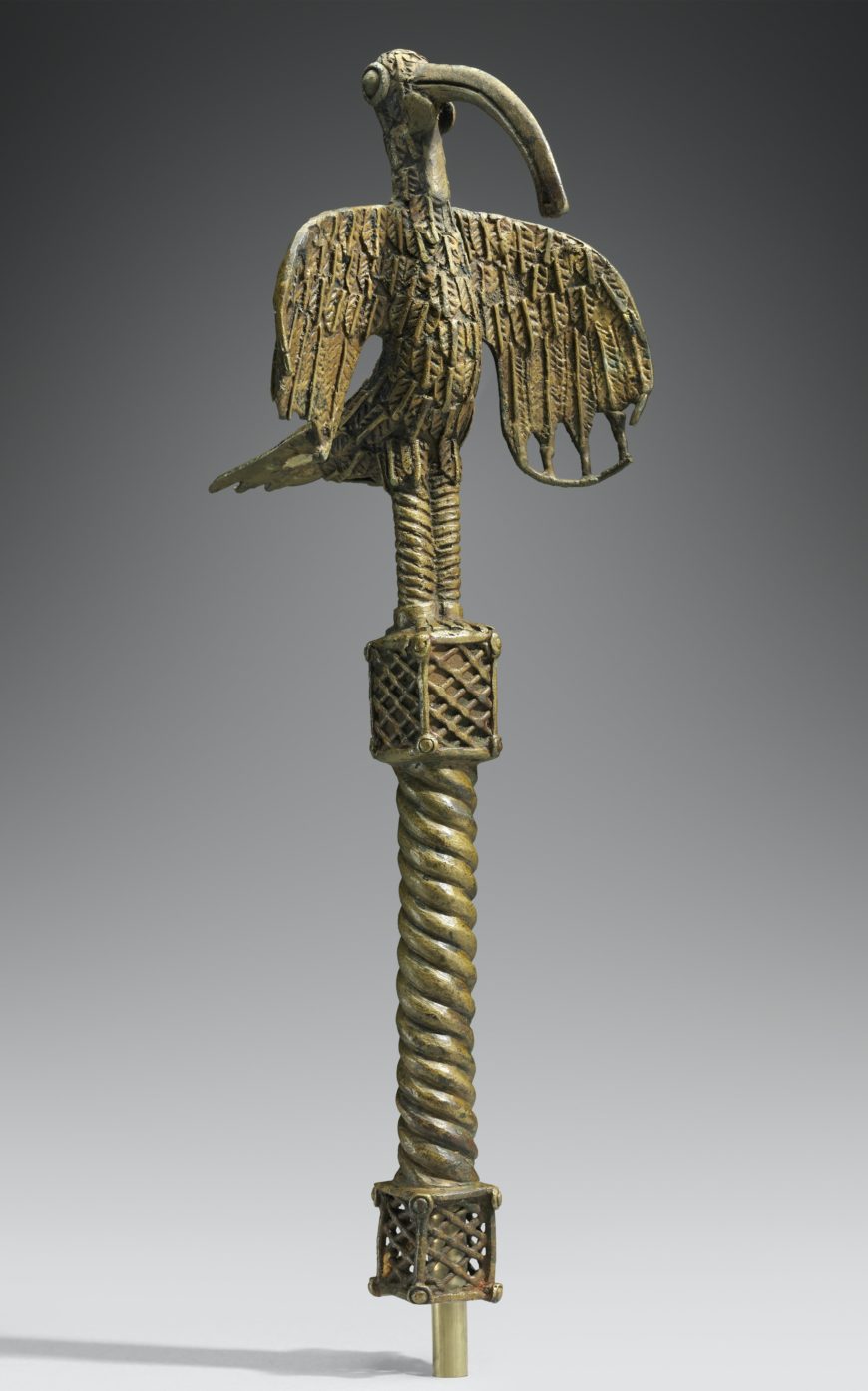
In the plaques he commissioned to ornament his audience hall, Esigie surrounded himself with images of courtiers in processions, including the festival of Ugie Oro, or engaging in other acts of service and praise—reminding them to honor and obey his authority. Today, artworks from the period of Esigie’s reign are among the most celebrated in African art history, combining fascinating narratives on the majesty of the kingdom, luxurious materials, and fine workmanship.
Royal Patronage in the 18th and 19th centuries
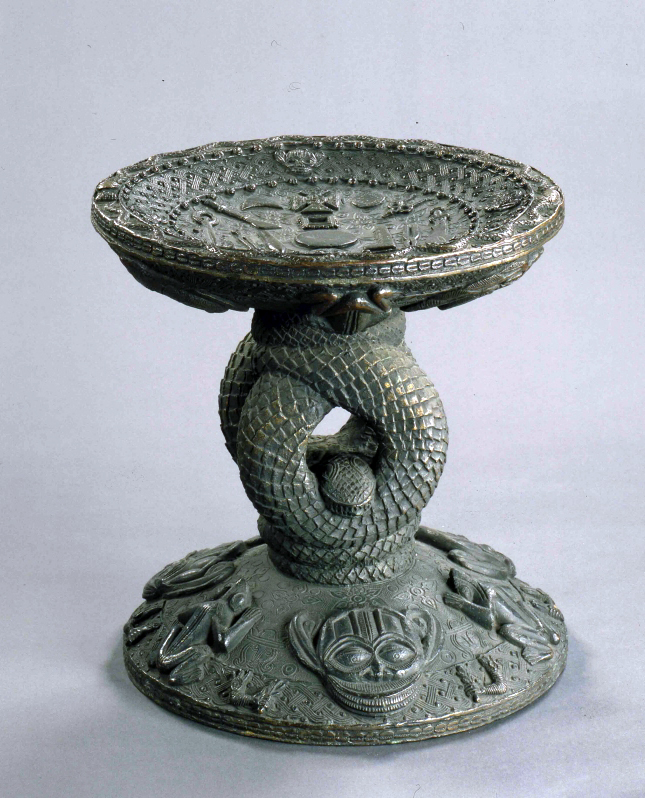
Changes in Benin art are tightly intertwined with the changing fortunes of the kingdom, because the Oba was historically the primary patron for all artwork in bronze and ivory. In the beginning of the eighteenth century, Benin recovered from a series of succession struggles and wars that weakened the court and devastated its finances. Oba Akenzua I and his successor, Oba Eresoyen, strengthened the king’s role and instituted new traditions and art forms to signal their regained power.
Akenzua and Eresoyen ushered in a period of renewed wealth and political power for the kingdom that continued into the 19th century. Akenzua and Eresoyen compared themselves to Ozolua and Esigie, starting the tradition of viewing Ozolua and Esigie as two of the most important kings in Benin history.
Oba Eresoyen was a major patron of the bronze-casting guild, and commissioned an elaborate copy of a bronze state stool owned by Oba Esigie—metaphorically connecting the two reigns. Eresoyen is also known as a patron of the ivory guild, and may have introduced the intricately carved tusk for memorial altars that first appear in the eighteenth century.
On memorial altars, ten to sixty tusks were displayed on top of brass commemorative heads. The tusk held in the Berlin Ethnographic Museum, is one of the oldest known. We see an Oba, his arms supported by attendants, placed in the center of the tusk, the most visible position. Surrounding this central triad are figures relating to the dynasty of great Obas—including two Portuguese men on horseback that refer to the reigns of Ozolua and Esigie—and motifs representing leading courtiers and priests serving the king.
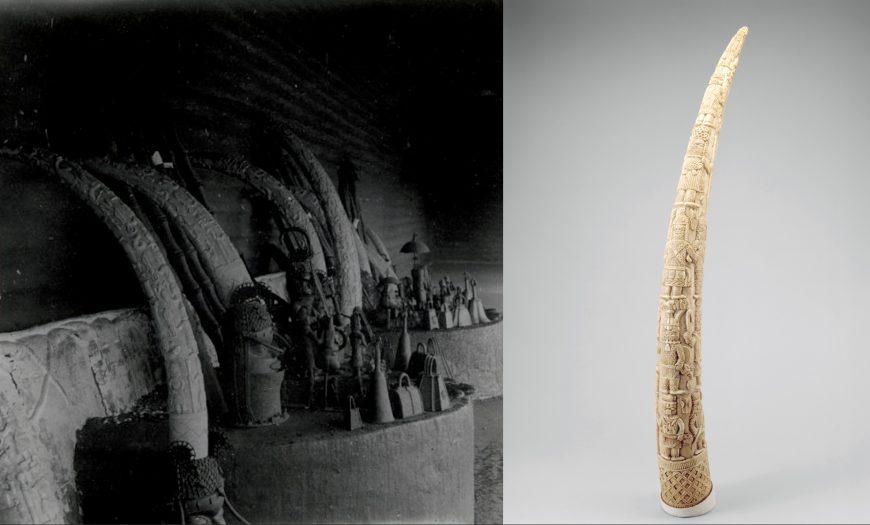
The Artists
The Igun Eronmwon (brass-caster’s guild), and the Igbesanmwan (ivory and wood carvers’ guild), are responsible for all the art made for the Oba. Until the 20th century, royal artists were not allowed to make pieces for other clients without special permission. Membership in the royal artists’ guilds is hereditary—even today. The head of each guild inherits his position from his father. He is responsible for receiving commissions from the king, overseeing the design of the work, and assigning parts of the project to different artists. For this reason, nearly all historical Benin art is made in a workshop style, with individual artists contributing pieces of the whole.
While the Igun Eronmwon and Igbesanmwan guilds are separate, they often make artworks that are displayed together. Commemorative heads made for the memorial altar of a king (see ancestral altars above), for example, combine a cast-bronze head with a carved ivory tusk rising from the top, just as an ivory leopard may be finished with inlaid bronze spots.
Controversy
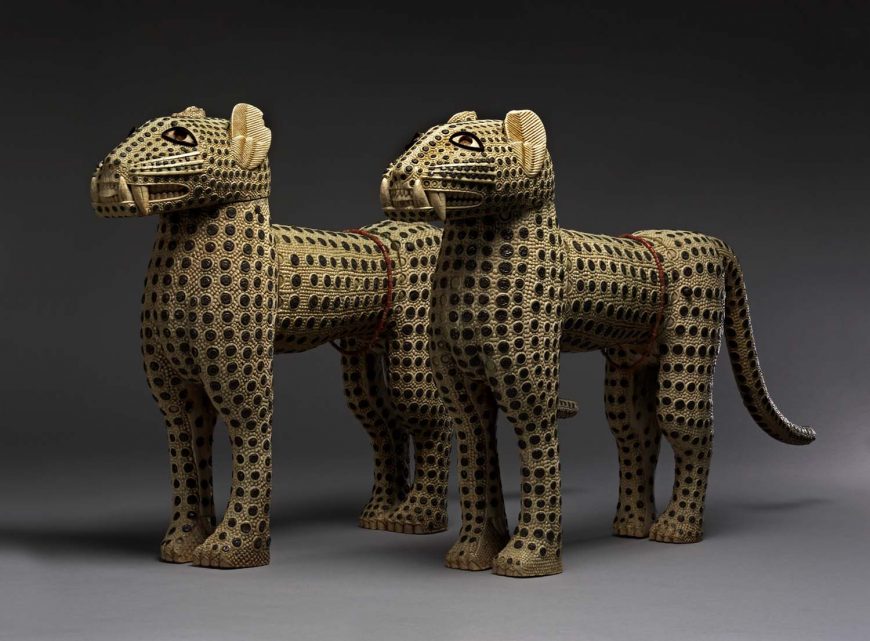
Like other artworks taken from their place of origin by colonial occupiers, artworks from Benin are part of a public conversation on cultural patrimony and the ethics of collecting. The provenance (ownership history), of Benin artworks in Europe and America usually includes a moment in 1897 when Benin City was invaded by British soldiers and a part of the royal treasury was claimed by the British state as spoils of war. In the following years, other artworks were taken from Benin by individual soldiers, or pillaged from the palace and sold.
Today, the palace in Benin City and the Nigerian government both claim ownership of Benin art held in foreign collections. Museums and private owners have provided a spectrum of responses. In 2014, British citizen Mark Walker returned two Benin artworks he inherited from his grandfather, a soldier in the 1897 invasion, to reigning Oba Erediauwa, because he felt that the Oba was the only rightful owner. The Rhode Island School of Design (RISD) Museum is working to determine how to return a commemorative head to Nigeria, given the competing claims of the palace and the government.
A coalition of European museums that hold the largest collections of Benin art have been meeting with representatives of the palace and the Nigerian government since 2007, and at present plan to collaborate by sharing their collections through loans to a new Nigerian museum built on palace grounds. The public conversation on Benin art weighs the competing ownership claims of the palace and the government, the ethical obligation to respect communities’ rights regarding their cultural patrimony, and the belief that museum collections should present world art to foster cross-cultural understanding.
Additional Resources:
Art of the Benin Kingdom at the Museum of Fine Arts, Boston
Benin chronology on The Metropolitan Museum of Art’s Heilbrunn TImeline of Art History
Kathryn Gunsch, The Benin Plaques: A 16th Century Imperial Monument (Routledge Research in Art History, 2017)
Paula Ben-Amos, Art, Innovation, and Politics in Eighteenth-Century Benin (Bloomington: Indiana University Press, 1999)
Barbara Plankensteiner, et al, Benin Kings and Rituals: Court Arts from Nigeria (Vienna: Kunsthistorisches Museum mit MVK und ÖTM, 2007)
The Imagery of Power on Benin Bronze Plaques
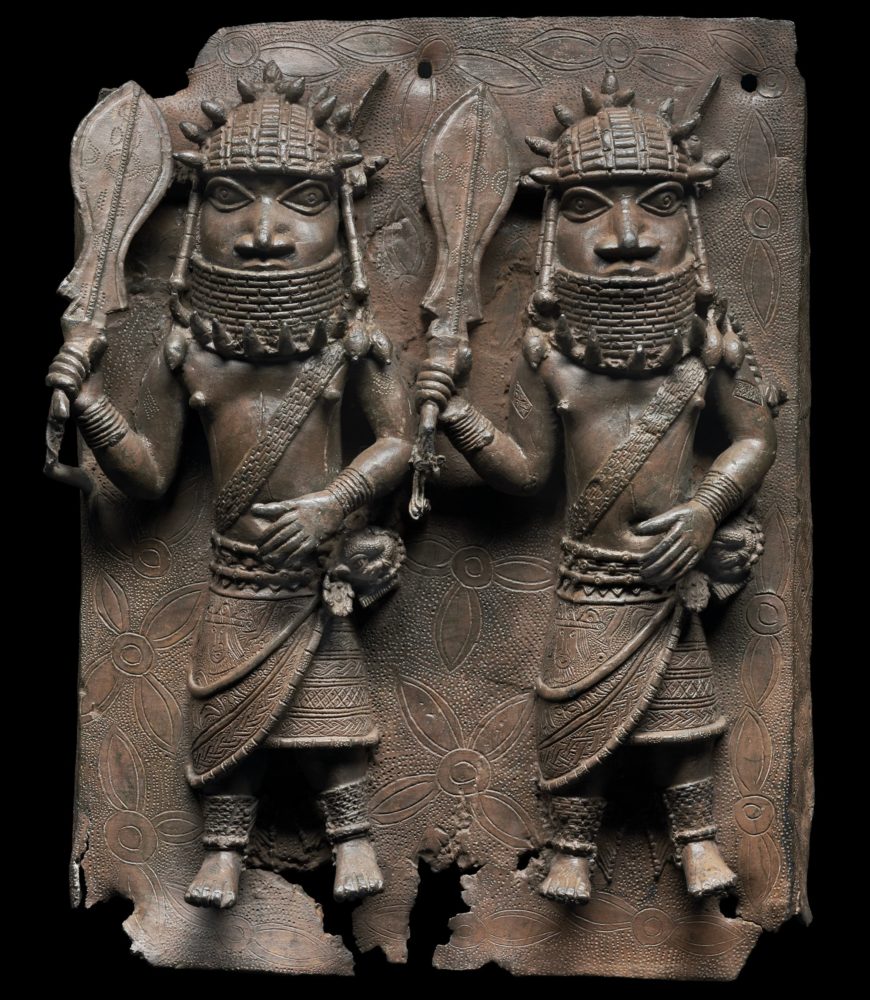
Designed to impress
Think of the last time you saw an interior space that impressed you. Whether you were watching Game of Thrones or reality TV, walking onto a college campus or into a major museum for the first time, some spaces are designed to wow—and intimidate—visitors. The audience hall in the palace in Benin City, in present-day Nigeria, was a space made to wow. It communicated to visiting ambassadors, traders, courtiers, and subjects the power and wealth of the Oba (the king).
Privileged regalia
During the sixteenth century, the pillars of the Oba’s audience hall would have been covered in bronze relief plaques like the one above. Two men stand with their feet firmly planted on an imagined plane. The men wear coral beaded regalia from head to toe—coral crowns, special high collars called odigba that signal their elite rank, beaded sashes across their chests, and beaded bands around their wrists and ankles.
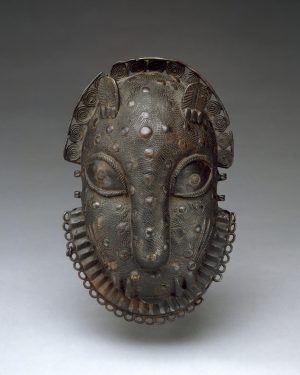
Only the Oba could grant permission to wear coral, an imported luxury related to his control of overseas trade with Portugal and, later, the Dutch, English, and French. The coral and the river-leaf pattern in the background also refers to Olokun, the god of wealth whose palace is under the sea.
The scars on the men’s chests, called iwu, were the mark of Benin subjects until the late nineteenth century. While the men’s attire signals their position within the court and their reliance on the king, their gesture announces that they are loyal and obedient subjects. Each figure holds a special fish-shaped sword, called an eben, aloft. Even today, these swords are used to dance in honor of the Oba. During palace festivities, courtiers throw them spinning into the air and catch them before they touch the ground — a display to honor the king.
Decoration for a grand palace
The plaque above was originally displayed on a pillar in an audience hall located deep within the palace. Pillars held up the roof of a veranda with built-in seating that ran around a large open-air courtyard in the center.
Historical accounts from visiting traders to Benin City suggest that the audience courtyard was roughly 30 by 60 meters (98.43 x 196.85 feet) [1] and could fit 500 people.[2] Likely beginning during the reigns of Oba Esigie (who ruled from 1517 to the 1550s) and his son Orhogbua (who ruled from the 1550s–1570s), the pillars surrounding the audience court were covered with more than 850 bronze relief plaques like this one.
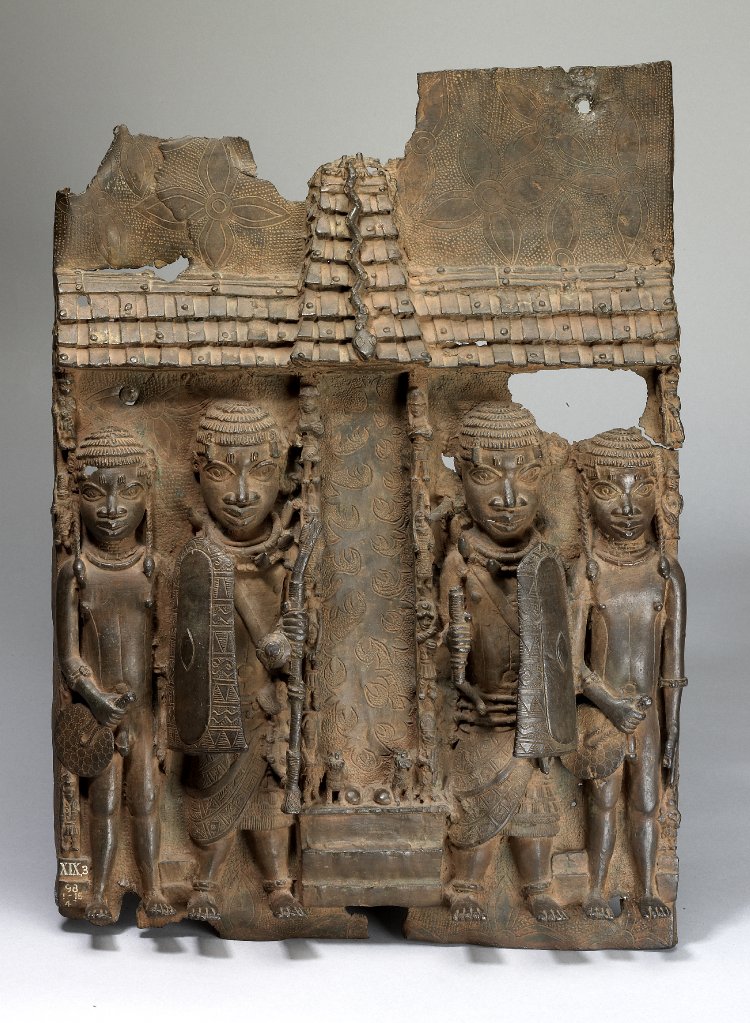
A surviving plaque shows what the audience hall must have looked like at the time, with a high roof ornamented by a cast-bronze snake and depictions of courtiers and warriors on the plaques decorating the pillars below. Hanging on all sides of the columns, the plaques would have created the impression that the pillars were of solid bronze — a form of currency at the time.
The plaques were deinstalled from the audience court in Benin City before the beginning of the eighteenth century, and kept in a storeroom within the palace until the British invasion of 1897. They are kept today in museums in Nigeria, the UK, Germany, Austria, and the United States. Recent research suggests that the plaques were made in three separate periods.
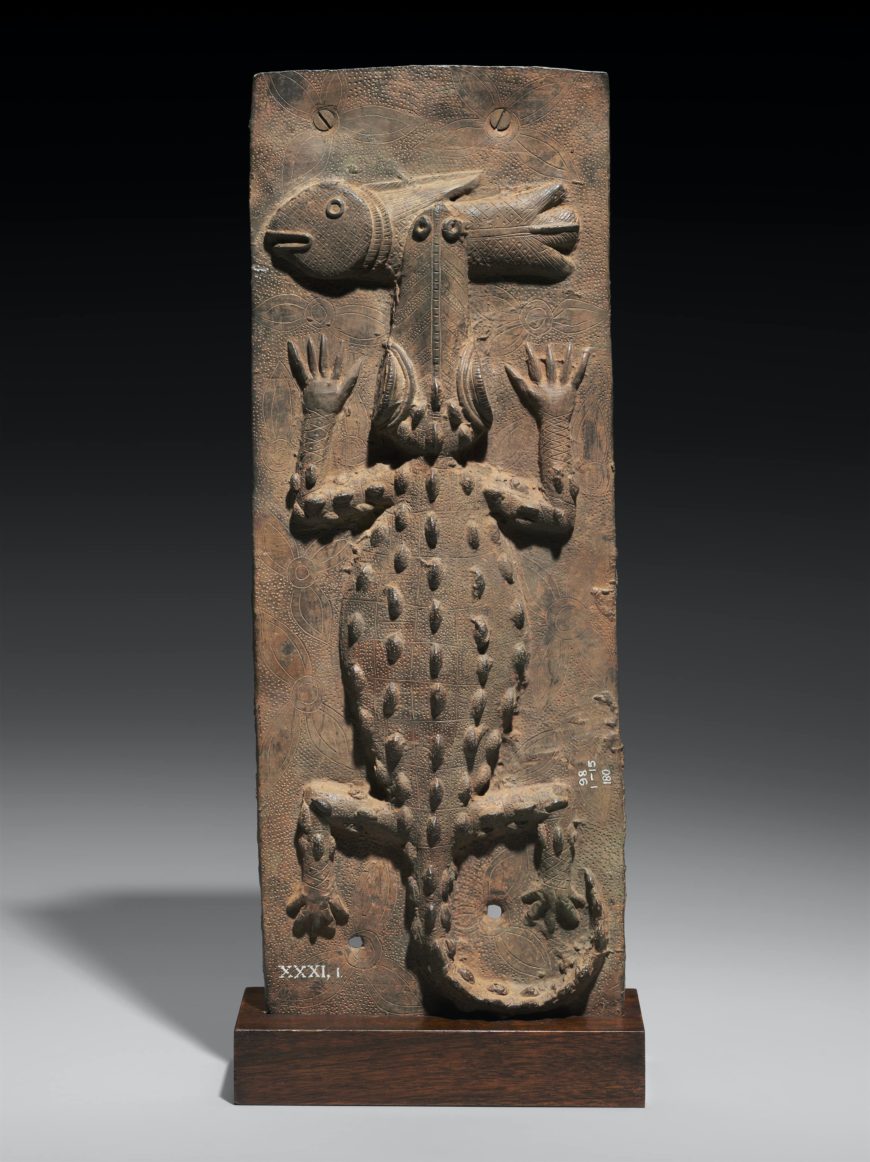
Casting in bronze
The plaques were all made using the lost wax method, where an artist creates a form in wax, covers it in layers of clay, and bakes the mold until the wax runs out. The artist then pours molten bronze into the hardened clay form, and breaks the form to release the final casting.
The early plaques are all low reliefs, meaning that they are fairly flat, without many details that rise off the surface of the plaque, like this plaque depicting a crocodile biting a mudfish.
From low to high relief
Low reliefs are easier to cast, because the artist does not need to worry about molten metal reaching each part of the form before it cools. In the later series of plaques, however, artists cast high reliefs, meaning that they have greater depth. In the plaque discussed above, the thin swords are fully free of the plaque surface, a daring compositional choice that required careful management of the hot bronze to fill the form.

The switch to high relief suggests that the artists were becoming more confident in the medium of bronze reliefs. It may also reflect the artists’ observations of how the completed reliefs looked once installed on the palace pillars. The later plaques, characterized by high-relief compositions of human figures that fill the entire surface, would have been easier to see from across the large courtyard.
Art for legitimacy
Why did the kings of Benin commission this ambitious program of court decoration? Oba Esigie fought his brother for the throne and then faced an attack from a neighboring army and the disobedience of his senior courtiers. He may have commissioned the plaques to assert his wealth and power to internal and external enemies, creating the impression of a strong monarchy despite the rocky start to his reign.
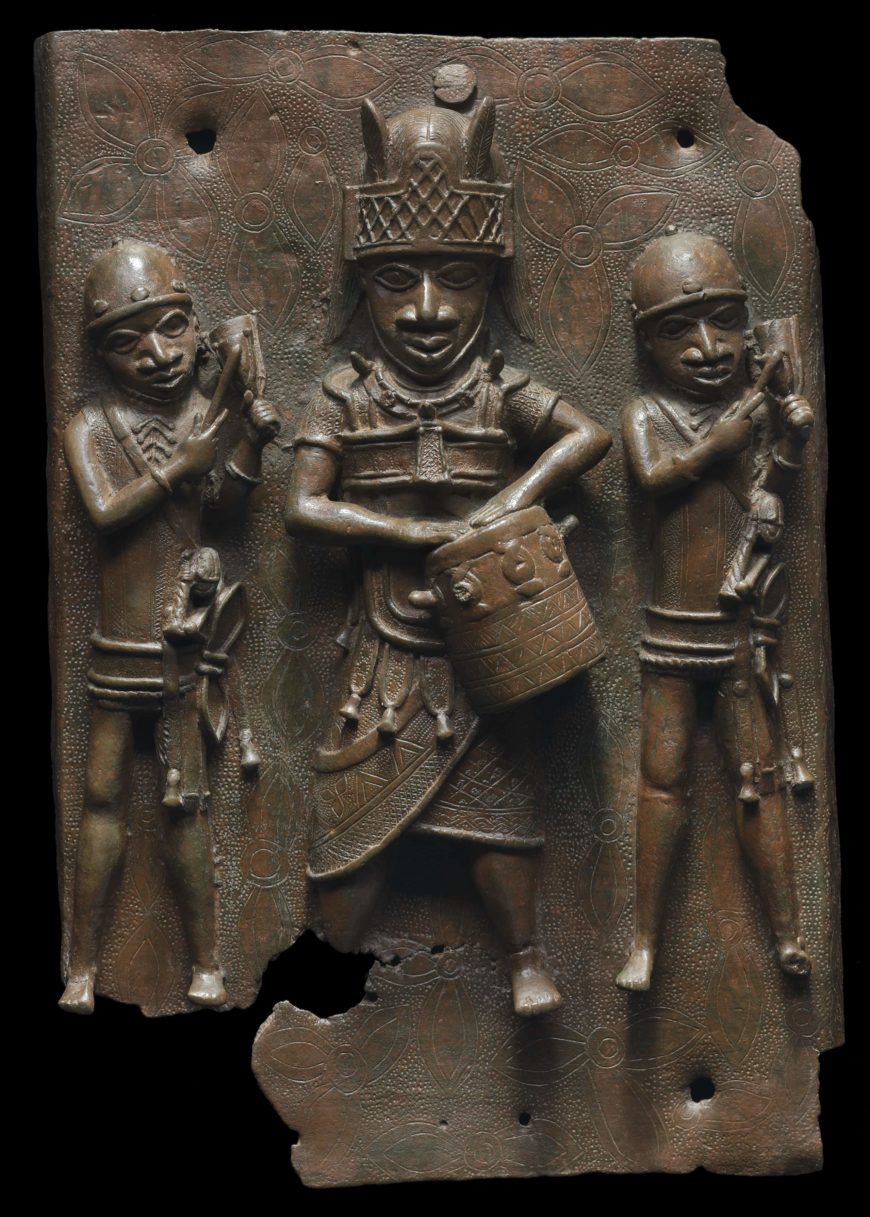
The earlier plaques depict elements of regalia and metaphorical animals relating to the Oba, as well as courtiers and warriors depicted in simple, three-person compositions in hierarchical scale, where the most important person is largest. All of these motifs indirectly allude to the king and his power. The narrative presented by the later plaques more explicitly honors the might and authority of the king.
Rather than referring to the Oba through court regalia or metaphorical creatures, these compositions depict people in direct service to the crown: participating in processionals, battles or ceremonies, like the men holding the eben dance swords. The plaque commission was likely one element in cementing Esigie’s authority. By the end of his reign and through the reign of his son Orhogbua, the court gave greater support to the monarchy.
Notes
- Translation of Olfert Dapper’s Naukeurige Beschrijvingen der Afrikaensche gewesten, 1676 edition, published in Adam Jones, Olfert Dapper’s Description of Benin (1668) (Madison: University of Wisconsin Madison, 1998), p. 11.
- A.F.C. Ryder, “The Benin Missions,” Journal of the Historical Society of Nigeria, 2, no. 2 (1960), p. 244.
Additional resources
Read more about a chronology for Benin art
Kate Ezra, Royal Art of Benin: The Perls Collection (New York: Metropolitan Museum of Art, 1992).
Kathryn Gunsch, The Benin Plaques: A 16th-Century Imperial Monument (Oxford: Routledge, 2018).
Barbara Plankensteiner, et al., Benin Kings and Rituals: Court Arts from Nigeria (Vienna: Kunsthistorisches Museum mit MVK und ÖTM, 2007).
Benin and the Portuguese
Brass
Trade with the Portuguese probably encouraged the growth of brass casting in Benin at this time. Although West Africans invented the smelting of copper and zinc ores and the casting of brass at least as long ago as the 10th century, they did not produce enough metal to supply the casting industry of Benin city, which gave such splendor to the king’s palace. The Portuguese found a ready market for brass ingots, often made in the form of bracelets called “manillas.”
These were made in the Low Countries (modern Holland), traded throughout West Africa as a kind of currency, and melted down by the brass workers of Benin. When the Portuguese arrived in Benin, Nigeria, in the fifteenth century, they quickly started trading brass and copper for pepper, cloth, ivory and slaves. In the 1490s a Portuguese trader wrote that at Benin copper bracelets were more highly prized than brass ones.

The number of manillas in circulation increased dramatically from the sixteenth century when they became one of the standard trade currencies. Millions were made in Europe, along with brass and copper pots and pans, and imported into Africa for trade. Research by British Museum scientists has shown that objects like these were melted down and made into works of art such as the Benin bronze plaques.
A Portuguese soldier
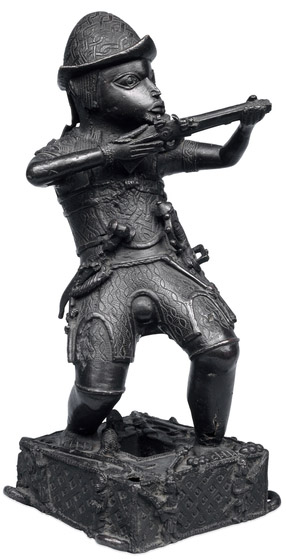
This is an image of a Portuguese soldier. He wears a typical 16th century European costume, with steel helmet and sword, and he carries a flintlock gun. Guns were new to the people of West Africa when the Portuguese arrived. So, Africans traded them from Europeans and learned to make them for themselves, to help them in their wars against peoples who still only had hand weapons or bows and arrows. Sometimes the king of Benin even employed Portuguese soldiers, like this man, to fight as mercenaries in his wars. Figures of Europeans such as this Portuguese soldier were kept on royal altars or on the roof of the royal palace in Benin city.
Control of trade
The rulers of Benin fought their neighbours for control to the supply of goods which could be traded to the Europeans on the coast. The king himself was in charge of trading slaves, ivory and other important goods, so that all the profit went to support his court and government.
Other merchants could only trade with the king’s permission. To prevent unauthorized trading, Europeans were seldom allowed to travel inland or visit Benin city.
Suggested readings:
J. Williams (ed.), Money: a history (London, The British Museum Press, 1997).
K. Yoshida and J. Mack (eds.), Images of other cultures (Osaka, National Museum of Ethnology, 1997).
P. Girshick Ben-Amos, The art of Benin (London, The British Museum Press, 1995).
© Trustees of the British Museum
Queen Mother Pendant Mask (Iyoba) (Edo peoples)
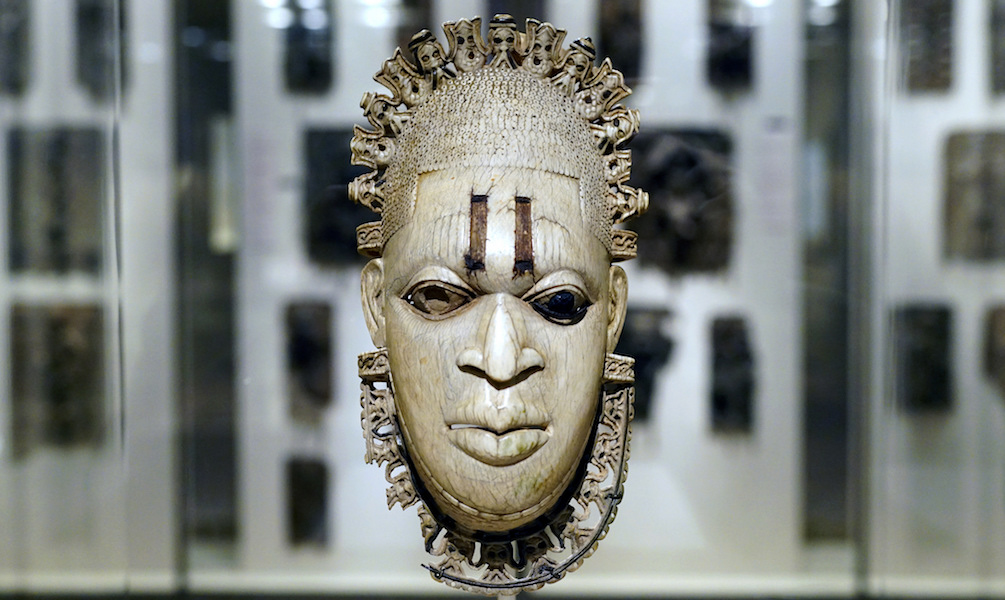
This pendant mask was created in the early sixteenth century for an Oba named Esigie, in honor of his mother Idia. The face has softly modeled, naturalistic features, with graceful curves that echo the oval shape of the head. Four carved scarification marks, a number associated with females, indicate her gender.
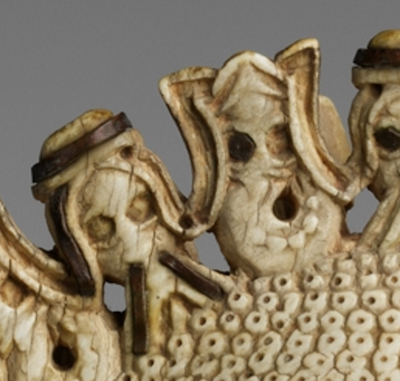
Iron inlays for the pupils and rims of the eyes intensify the Queen Mother’s authoritative gaze and suggest her inner strength. The two vertical depressions on her forehead were also inlaid with iron. She is depicted wearing a choker of coral beads and her hair is arranged in an elegant configuration that resembles a tiara. The intricately carved openwork designs are stylized mudfish alternating with the faces of Portuguese traders. Both motifs are associated with the Oba and his counterpart, the sea god Olokun. The mudfish is a creature that lives both on land and in water, and a symbol of the king’s dual nature as both human and divine. Similarly, the Portuguese, as voyagers from across the sea, may have been seen as denizens of Olokun’s realm. Like the sea god, they brought great wealth and power to the Oba.
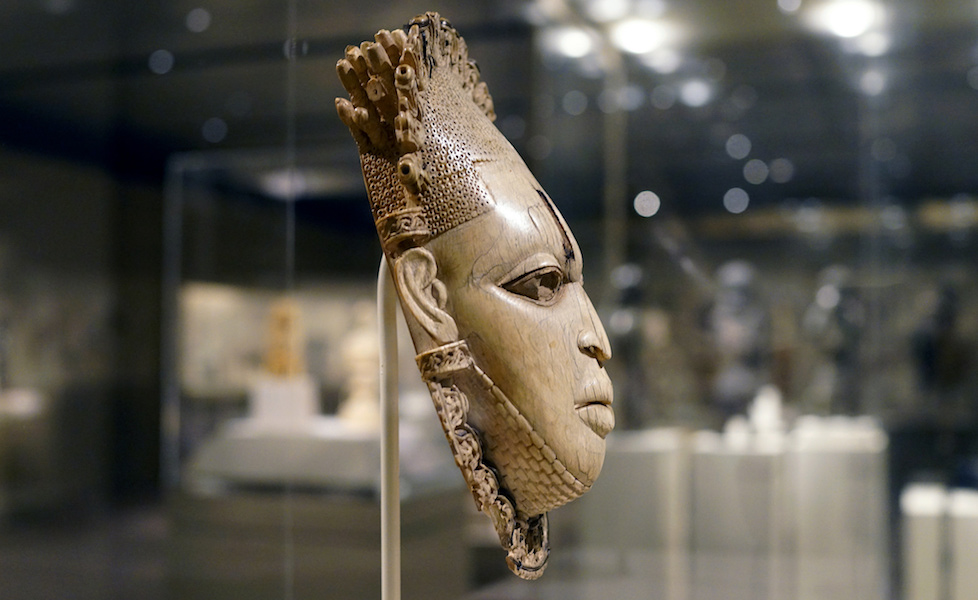
In Benin culture, ivory holds both material and symbolic value. As a luxury good, ivory was Benin’s principal commercial commodity and helped to attract Portuguese traders who, in turn, brought wealth to the kingdom in the form of copper and coral. In addition, ivory is white, a color that symbolizes ritual purity and is also associated with Olokun, who is considered to be a source of extraordinary wealth and fertility.
Queen Idia is honored as a powerful and politically astute woman who provided critical assistance to her son during the kingdom’s battles to expand. Upon the successful conclusion of the war, Esigie paid tribute to Idia by bestowing upon her the title of Queen Mother, a custom that has continued with subsequent rulers until the present time. The title of Queen Mother, or Iyoba, is given to the woman who bears the Oba’s first son, the future ruler of the kingdom. Historically, the Queen Mother would have no other children and, instead, devote her life to raising her son. Oba Esigie is said to have worn the mask as a pectoral during rites commemorating his mother. The hollow back, holes around the perimeter, and stopper composed of several tendrils of hair at the summit suggest that the mask functioned as an amulet, filled with special and powerful materials that protected the wearer. Today, such pendants are worn at annual ceremonies of spiritual renewal and purification.
© 2006 The Metropolitan Museum of Art, New York (by permission)
Additional resources:
Smarthistory images for teaching and learning:

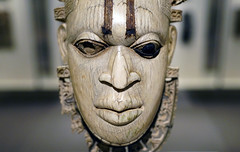
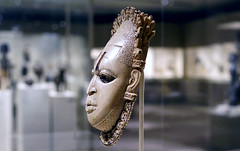
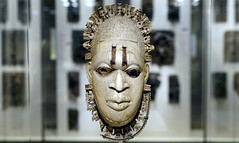
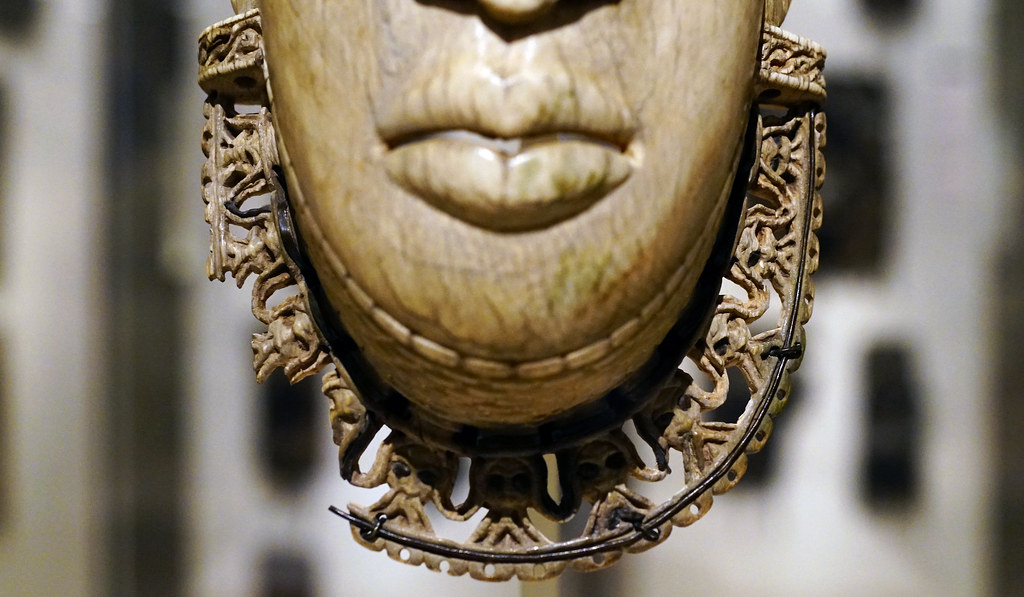
Benin ivory mask (Edo peoples)
by HENI TALKS
Gus Casely-Hayford - 'A Physical Essay in Power': The striking story of a Benin ivory mask from HENI Talks on Vimeo.
Cultural Historian Dr. Gus Casely-Hayford tells the remarkable story of a sixteenth century ivory mask from Benin, West Africa.
Contrary to its serene visage, Casely-Hayford explores how this finely carved artefact is a ‘physical essay in power’: a testament to subterfuge, savvy trading networks and bloodshed. Casely-Hayford also reflects on the mask’s changing status in the British Museum over the course of the past century, and how such objects – once regarded as ‘primitive’ – had a profound impact on the Western twentieth century avant-garde. With the rise of post-Colonial theory, such works in Western collections are now securing the status that their cultural significance merits.
Benin plaque: Equestrian Oba and Attendants
by GREG STUART
Royal history rendered in brass

This remarkable brass plaque, dated between 1550-1680, depicts an Oba (or king) and his attendants from the Benin Empire—a powerful kingdom located in present-day Nigeria. We know that the central figure is an Oba because of his distinctive coral beaded regalia. Also, attendants hold shields above his head, either to protect him from attack or possibly from the hot, tropical sun. This was a privilege only afforded to an Oba.
The figures around him range in size, not because of their actual height or distance from the Oba, but rather due to their level of importance within the court. This convention of sizing human figures based on status is known as “hierarchic scale” and is found in artwork from cultures around the world and across time. The Oba would have travelled with a large cohort of attendants, warriors, servants, diplomats, chieftains, and priests.
The plaque originally hung alongside many others on posts throughout the palace of the Oba. The order of their placement on these posts would have told the history of the royal lineage of Benin’s Obas, who traced their dynasty all the way back to Oranmiyan, whose son was the first Oba of Benin. However, the sequence of plaques is lost to us since they were long held in storage when found by westerners in the 19th century. You may notice that the Oba rides sidesaddle on horseback, which would seem to indicate a connection to Oba Esigie (who ruled c. 1504-1550), the first Oba to travel by horse. However, without knowing the original order of the plaques, we will never know for certain whether this was Esigie, or a later Oba who emulated his brash new mode of travel.
Artists working in brass were organized under Esigie. Today, artists working in brass in Benin are part of a brass workers guild, and it was likely that previous generations would have also worked collectively. These artists created plaques and other sculptures using what is known as the “lost wax casting technique,” in which, first, a more malleable wax version of the final brass work is made. It is then covered in clay and fired to harden the clay, removing the wax, which melts away in the process (hence the term, “lost wax”). Hot, molten liquid brass is then poured into the clay mold. As the brass cools, it hardens, and the clay is removed, revealing the finished plaque.
Crossing cultures: a record of trade
Almost every detail in this work speaks to the Benin Kingdom’s mutually beneficial trade with Portugal, which first made contact with Benin in the late 15th century. The Portuguese received items like peppers, cloth, and stone beads from Benin, while Benin received—among other items—the coral that makes up the beads worn by the Oba, and even the brass that makes up this plaque in the form of manillas, or armbands, worn by the Portuguese, which would have been melted down as the raw material for this plaque.


The rosette shapes that adorn the background of the plaque were possibly derived from Christian crosses brought by these European traders. Even the horse that the Oba rides was originally introduced to West Africa from across the sea. There is nothing quite like these plaques in all of Africa or Europe from this period, and some scholars speculate that they were created as a way of reconciling traditional African brass sculptural forms with the illustrated books and prints that may have been in the possession of European travelers.
Troubled Legacy
Trade began to decline with Portugal as the Portuguese empire waned in the 18th century. By the 19th century, Britain was seeking to make inroads with Benin as a new trading partner. However, this partnership was much less mutually beneficial and was marked with frequent tension. After increased aggression from both nations, the British launched the Punitive Expedition of 1897, seizing the Oba’s palace, burning down the city around it, killing many, and looting the royal court’s vast stores of art and treasure.

We know that this plaque was one of the artworks looted in the siege because Norman Burrows, a known trafficker in stolen Benin objects, owned it briefly during this time. This act of looting perpetrated by the British was later condemned as a criminal and violent act of British imperialism and colonialism. As such, there are many who believe that objects such as this plaque should be returned to the people of Benin, who remain deeply connected to their history and cultural traditions. However, there are others who feel that these remarkable objects are part of the world’s heritage, and thus should remain in museum collections around the world as testament to this artistically rich culture.
Backstory
A consortium of European museums called the “Benin Dialogue Group,” formed in 2007, has been meeting with representatives from Nigeria to discuss issues around repatriation. Their hope is to establish a system of rotating loans of artworks to Benin City, though the security and guaranteed return of the objects is a point of ongoing discussion, set to continue at a conference in 2018. The consortium includes representatves from the British Museum and Berlin’s Humboldtforum, two of the institutions that hold the largest collections of objects from Benin. Other members of the group include museums in Cambridge, Vienna, Stockholm, Leiden, Leipzig and Dresden, Oxford, and Hamburg, and London. Museums in the United States and France, which also hold significant numbers of Benin artworks, have yet to become formally involved, though some, such as the Musée du Quai Branly-Jacques Chirac in Paris, have been approached directly with restitution claims from Nigeria.
The ongoing dialogue between museums and nations from which important objects, like those from Benin, were forcibly removed, highlights the complexities of the current, post-colonial world. Should formerly colonized areas be repaid for the damage inflicted on them by colonial powers? Who is responsible for doing so, and how? Who has the ethical right to the ownership, display, and preservation of these important pieces of cultural heritage? The formation of consortia like the Benin Dialogue Group is a significant first step towards resolving some of these thorny and pressing questions.
Backstory by Dr. Naraelle Hohensee
Additional resources:
The Art of Africa: A Resource for Educators (publication by The Metropolitan Museum of Art, available online)
Benin chronology on The Metropolitan Museum of Art’s Heilbrunn Timeline of Art History
Benin from the Dallas Museum of Art
Kate Ezra, Royal Arts of Benin: The Perls Collection (New York: The Metropolitan Museum of Art, 1992).
Barbara Plankensteiner, (ed.). Benin Kings and Rituals: Court Arts from Nigeria (Ghent, Belgium: Snoeck Publishers, 2007).
“Looted Benin bronzes to be lent back to Nigeria,” The Art Newspaper, October 16, 2017
Smarthistory images for teaching and learning:














Ere Ibeji Figures (Yoruba peoples)
by DR. PERI KLEMM
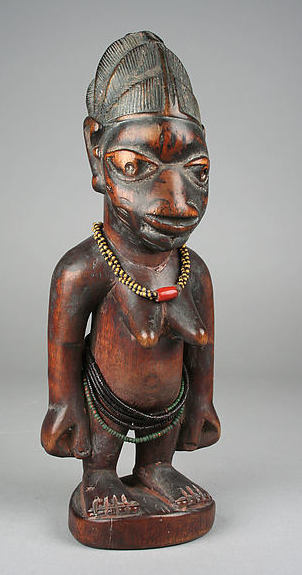
The Yoruba have one of the highest rates of twining in the world—it is estimated that out of every 1,000 births, 45-50 result in twins. Twins are revered among the Yoruba and come into this world with the protection of the orisha (deity) Shango who is evoked at the baby’s naming ceremony when he or she is a few months old. Due to the low birth weight of twins and the high infant mortality rates in Nigeria, many twin babies do not live long. If a baby dies during childbirth, in the months leading up to the naming ceremony, the parents will seek consultation with an Ifá diviner, a Babalawo. If the Babalawo ascertains a spiritual cause, he will help the parents find a carver to create an Ere ibeji figure. An Ere ibeji is a wooden carving of a male or female figure once used by the Yoruba. The figure is thought to be a focal point for the spiritual energy of the deceased twin who, according to Yoruba traditional thought, resides in the supernatural realm where he/she is cared for by a spiritual mother.
Families, particularly grieving mothers, take comfort in the belief that a spiritual mother is caring for and guarding the departed child. The Ere ibeji is ritually washed, fed, clothed and carried in a cloth wrapper on the mother’s back as a real baby would be carried. The Ere ibeji might also be decorated with camwood powder, blue paint, beads, shells, and precious textiles. But despite the fact that this carving can serve as a receptacle for the spirit of the dead child, Ere ibeji figures do not look like children. These figures are carved to represent an ideal type within the Yoruba criteria of beauty and in the prime of life—neither a child nor an old person.
The carving style emphasizes the conical head, an elaborate hairstyle, a roundness of the eyes and facial features, and a balanced composition between the body parts. Each of these features references a moral virtue or inner goodness all children should cultivate. Ere ibeji carvings reveal not only the importance of twins and a strong belief in the afterlife, but what Yoruba regard as beautiful and correct.
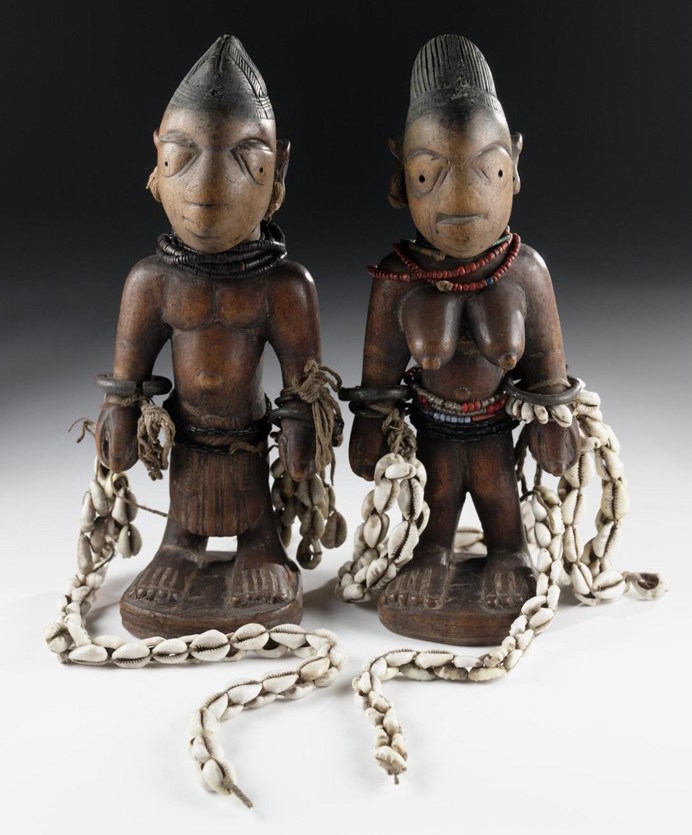
In the last fifty years, the practice of commissioning a carver to create an Ere ibeji has waned. Ere ibeji figures have become Western collector’s items and artists are now carving for the tourist market. However, the practice of using spiritual figures has not stopped, though since the 1970s some parents have chosen to use manufactured, imported dolls or photographs instead of carved figures as receptacles for the spiritual energy of the deceased. These materials are generally less expensive, worldly, and modern. While Ere ibeji carvings have a distinct style, the fact that another medium can successfully serve the same purpose suggests that for the Yoruba, art is dynamic and flexible. While Western collectors demand an Ere ibeji that is similar to the image above, Yoruba practitioners were not constrained by a stylistic cannon and specific materials. For indigenous users, it is the concept behind this art making practice that is most important.
Additional resources:
Yoruba peoples on Art and Life in Africa (University of Iowa)
Kingdom of Ife: Sculptures from West Africa

Ife ( pronounced ee-feh) is today regarded as the spiritual heartland of the Yoruba people living in Nigeria, the Republic of Benin and their many descendants around the world. It is rightly regarded as the birthplace of some of the highest achievements of African art and culture, combining technical accomplishment with strong aesthetic appeal.
From the 12th to the 15th centuries, Ife flourished as a powerful, cosmopolitan and wealthy city-state in West Africa, in what is now modern Nigeria. It was an influential centre of trade connected to extensive local and long-distance trade networks which enabled the region to prosper.
Sculpture

The artists of Ife developed a refined and highly naturalistic sculptural tradition in stone, terracotta, brass and copper and created a style unlike anything in Africa at the time. The technical sophistication of the casting process is matched by the artworks’ enduring beauty. The human figures portray a wide cross-section of Ife society and include depictions of youth and old age, health and disease, suffering and serenity.
According to Yoruba myth, Ife was the center of the creation of the world and all mankind. Ife was home to many sacred groves located in the city’s forests. Two groves in particular have revealed numerous sculptures: the Ore Grove with its stone monoliths, human and animal figures and the Iwinrin Grove which is associated with terra-cotta heads and fragments from life-size figures.
The identification and function of this head, in common with the others discovered at this site, remain uncertain. Its elaborate beaded headdress, possibly representing a crown, suggest that it was associated with an Ooni, a ruler of Ife.
Other sites have revealed spectacular pieces with royal associations, including the only known complete king figure and an exquisite terra-cotta head, possibly portraying a queen both from Ita Yemoo.
Ife today
Today Ife remains a major spiritual and religious centre for the Yoruba people. Some of its shrines and groves are still in use and rituals to key gods are performed regularly. Works of art from Ife have become iconic symbols of regional and national unity, and of pan-African identity. Since Independence in 1960 enthusiasm for copies or reproductions of heritage items with nostalgic associations has increased. The “Ori Olokun” head was chosen as the logo for the All-Africa Games held in Lagos in 1973 and has been adopted as the logo of numerous commercial, educational and financial institutions. Such images have become universal symbols of African heritage.
© Trustees of the British Museum
Ife uncovered
Video \(\PageIndex{10}\): Professor John Picton and metallurgist Paul Craddock discuss the meaning and the making of the sculptures in the exhibition Kingdom of Ife sculptures from West Africa. © Trustees of the British Museum. Created by British Museum.
Little was known of the Ife civilization—that is until seventeen cast bronze heads were found by chance.
Olowe of Ise
Olowe of Ise, veranda post (Yoruba peoples)
by DR. PERI KLEMM, DR. STEVEN ZUCKER and DR. CHRISTA CLARKE
Video \(\PageIndex{11}\): Olowe of Ise, Veranda post, before 1938, Nigeria, Yoruba peoples, wood, pigment, 180.3 x 28.6 x 35.6 cm (The Metropolitan Museum of Art, New York City). Speakers: Dr. Peri Klemm and Dr. Steven Zucker
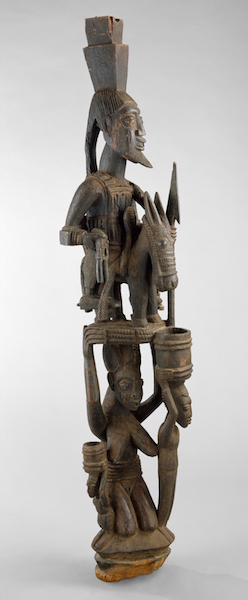
In the early twentieth century, a Yoruba ruler commissioned this architectural column from one of the most renowned sculptors in the history of Yoruba art, Olowe of Ise. Born in the nineteenth century in Efon-Alaiye, a famed carving center, Olowe moved as a youth southeast to Ise. There, his artistic reputation was established when he carved a program of architectural sculptures for its king, the Arinjale. Subsequent commissions of architectural sculpture for the palaces of other regional leaders brought Olowe even greater recognition as a master sculptor. Admired by his contemporaries, Olowe’s artistic talent is recalled in oriki, or praise poems, composed in his honor. His accomplishments were also recognized in the West. In 1924, a pair of his palace doors was exhibited in London and acquired for the British Museum.
Olowe created this veranda post, one of several, for the exterior courtyard of a Yoruba palace. Carved from one piece of wood, the composition combines two classic Yoruba icons of power and leadership. The most prominent of these is the equestrian warrior, who is depicted frontally sitting regally on a diminutive horse. He holds a spear and a revolver. The image of the mounted warrior symbolizes the military might needed to form kingdoms. Local leaders adopted this image to validate their rule. At the base of the post, the kneeling female figure is depicted as the dominant form. In Yoruba culture, women are honored as the source of human life and embody ideas of spiritual, political, and economic power. These allegorical representations underscore the wealth and power of the ruler who commissioned the work.
Here, as in other examples of African sculpture, proportion and scale are altered and exaggerated to symbolize ideas. The disproportionately large heads represent character, self-control, and motivation. Eyes are large to suggest awareness. Among the Yoruba, the most beautiful people have a gap between their upper front teeth. The woman’s exaggerated breasts symbolize her ability to have children and to nurture them. The woman is represented slightly larger than the warrior, suggesting that she is the essential support. The warrior’s horse, less important than its rider, is depicted as smaller. The subordinate role of the two youths by the woman’s side is suggested by their small scale.

Stylistically, Olowe was very innovative in his composition. He is especially known for the manner in which figures project beyond the immediate boundaries of the sculptural space. Here, instead of the usual Yoruba practice of depicting figures in frontal poses, he sculpted the female figure turning toward the left with the two smaller attendants radiating outward at oblique angles. The compressed style of the upper portion of the column, with its weighty and self-contained equestrian figure, contrasts with the sense of kinetic energy created by the dynamic composition of multiple figures below. The sculpture’s formal complexity is enhanced by its textured surface, with details originally painted in black, white, and royal blue. The deep carving style was well suited to the intense raking sunlight of its original setting just inside an exterior veranda.
The Yoruba, who live in southwestern Nigeria and southern Benin, are a diverse people with a rich cultural and artistic heritage of considerable antiquity. Although they number over 15 million people, the Yoruba embrace an overarching common identity through shared language and history. They trace the origins of both life and civilization to their founding city of Ile-Ife, which was a thriving urban center by the eleventh century. In the centuries that followed, numerous autonomous city-states developed, related through professed descent from Ile-Ife. In general, each city-state was governed by a sacred ruler, whose power was balanced by a council of elders. Artists working for these regional leaders produced a wide range of art forms designed to glorify the status of the king and his court.
© 2006 The Metropolitan Museum of Art, New York (by permission)
Smarthistory images for teaching and learning:














Olowe of Ise, Veranda Post of Enthroned King and Senior Wife

Like sculpture in Medieval Europe often created to embellish architecture, this magnificent work was commissioned for a principal entryway, originally one in a suite of five veranda posts. Hand carved from one sizeable piece of high-density hardwood timber, this work by the renowned Yoruba artist Olowe of Ise originally measured more than five feet high.
He has skillfully created a complex composition comprised of five figural elements on a circular base: the crowned king, his senior wife, and three smaller attendants (one now missing) in the royal household. Portrayals of rulers and their privileged power of earthly and divine authority unite the many global art traditions across time and space.

Master carver
Similar to the systems of Medieval European guilds of craftsmen, nineteenth- and early twentieth-century Yoruba artistic traditions were maintained by artists working in specialized carving centers throughout the southwest area of Nigeria. “Master carver” designated a person who attained the skills through training and advanced from apprentice to master within a locally established carving center or compound. A carver with exceptional talent often set up a studio on his own, accepted apprentices and assistants, and was commissioned directly.
One great master carver, Olowe of Ise, became a widely celebrated artist for his virtuosity of invention and design developed through the production of a range of notable and important royal commissions in the early twentieth century. Born in the town of Ise, according to published accounts, most of his life was spent working in the court center of Ise though he took commissions from other royal patrons over a wide area in the Ekiti region.

Signature Style
Olowe’s highly original and unique style results from the variety of elements and details that he has made his own and that can be found in many of his published works. His remarkable ability to free the figures from the dense hardwood is unlike any other Yoruba carver. His virtuosity can be seen in the elegant balance of the fully three-dimensional figures in a tiered composition and placed in a variety of poses on a single base.
He treats the heads as a single ovoid form leading the eye to the crowned head of the king (Ogoga) and his attendant queen. The heads project at a diagonal angle that are mounted on highly elongated and slightly forward-bending necks, creating a distinct line down to their squared shoulders. The convention of elongating the figure, head, and neck can be seen in many of Olowe’s carvings, creating a solid “mounting” to visually highlight the importance of the head that holds ase, or the inner spiritual power, dignity, strength, and sacredness of one’s destiny.
Yoruba traditional thought and belief is often made manifest through hieratic proportions. The status of the king’s consort is visually relayed by her physical size. However, it is balanced by the location of the seated king at the center of the post. His crowned head has been positioned so that it would be viewed at eye level in the original veranda setting. His feet are not allowed to touch the earth, a symbol of his transcendent position. His eyes are downcast, introspective, and attentive to the world beyond. He wears a conical beaded crown, signifying the legitimacy of his reign. The crown is decorated with four carved ancestral faces or ‘heads’ with open eyes, a reference to the divine line of descent and spiritual wisdom (ase) it contains.

The style of the hats with serrated lines can be found in many of Olowe’s works. In traditional Yoruba religious belief, the crown is the key emblem of the power of a sanctified reign, signaling the transformation of the human wearing it into a conduit to the spiritual, ancestral realm. Three small figures, scaled according to culturally-specific status, are at the base: a female who kneels in a gesture of humility and reverence; a standing court messenger identified by his half-shaved head playing a flute announcing the king’s presence; and a third, now missing, standing while holding a large circular fan, emblem of royalty and Osun, the river deity.


The king sits poised, leaning slightly forward, his weight held by his hands on his knees. A bird at the summit of his crown, a sign of transformational abilities and the protection of ancestral mothers, is rendered with an elongated beak that extends down to touch the very center of the beaded crown. Its tail points upward to the head of the standing consort who wears three vertical parallel facial marks with a line running from the left side of the bridge of the nose, identifying lineage to a principal Yoruba family, the Egbas.
She displays a once common practice in the Ekiti area of filing the front teeth as a sign of beauty and rank. Her elaborate hairstyle would reflect one worn for a festival honoring a deity (orisha) or during a chieftaincy installation. On her back, Olowe has replicated the queen’s striking scarification patterns that are associated with her community and high status.
The formidable queen stands erect behind and towering over the king, yet they are visually connected by her hands gently resting on the back of the throne. Beaded coral adornments worn by the king and queen echo the form of their squared shoulders, and other beaded adornments are included, worn by entitlement as a member of the royal household. Traces of blue, red, and white pigments can be seen. They were once most likely prominent, but the colors have faded over time as the work was exposed to the outdoors.
A suite of five architectural posts commissioned from Olowe by the crowned king (Ogoga) of the town of Ikere, in Ekiti state, could be found situated in the principal entry to the local palace veranda and reception courtyard. Three of the major carvings appear to be functional supports, extending to the top of the veranda roof. Two multi-tiered figural posts flank a central geometric form, while two others facing outward represent a senior mother presenting her twins and a royal equestrian. A smaller freestanding equestrian figural group is at the center.

Photographed in situ more than two decades later (1958 and 1964), three of the original works had been reinstalled under a newly replaced palace veranda. The enthroned king with his senior wife is repositioned at the center and facing outward toward visiting guests, flanked by the senior mother with twins and the royal equestrian. All three appear to be structural supports. All three are now in American collections.

Global Connections
Olowe of Ise was flourishing in southwest Nigeria in the early twentieth century, coinciding with the time when early Modernism was emerging in the avant-garde circles in Paris studios. African art was displayed in the Musée d’Ethnographie du Trocadéro in Paris, arriving in the late nineteenth century as a result of scientific expeditions and colonial conquest.

Constantin Brancusi would have been inspired by works from francophone colonies, as King of Kings demonstrates. Similar to Olowe’s veranda posts, this work was originally intended to stand in an architectural space, Temple of Meditation, a private sanctuary commissioned in 1933 by the Maharaja Yeshwant Rao Holkar of Indore.

Architect David Adjaye was inspired by the top element of another of Olowe’s veranda posts for his design of the National Museum of African American History and Culture, Washington, D.C. Smithsonian Institution. Depicting a notable equestrian leader, the multi-figural veranda post is on long term loan from the Museum of Five Continents, Munich, Germany and installed on the 4th floor.

Additional resources
Walker, R.A., Olowe of Ise: A Yoruba Sculptor to Kings, National Museum of African Art, Smithsonian Institution, Washington, D.C. 1998
Olowe of Ise in the Smithsonian National Museum of African Art
Ikenga (Igbo peoples)
by DR. PERI KLEMM and DR. STEVEN ZUCKER
Video \(\PageIndex{12}\): Ikenga, Igbo peoples, Nigeria, wood (University of Pennsylvania Museum of Archaeology and Anthropology)
These carved wooden figures have human faces but animal attributes, and reflected the achievements of their owners.
Smarthistory images for teaching and learning:














Uche Okeke
“Young artists in a new nation, that is what we are! We must grow with the new Nigeria and work to satisfy her traditional love for art or perish with our colonial past.”
—Uche Okeke, from the “Zaria Art Society Manifesto,” Natural Synthesis, 1960
The Art Society of Zaria
During the period leading up to and following Nigerian independence in 1960, artists appropriated cultural and aesthetic traditions from around the country as a means of defining a new national identity. They drew upon narratives from Yoruba, Igbo, Urhobo and other cultures, Bible stories, local histories and artistic traditions to inform the content and style of their works, manipulating tales from the past to produce a mythology for the present.
This practice was defined as “natural synthesis” by the Art Society at Zaria, an arts group formed in the late 1950s by Uche Okeke, Demas Nwoko, Simon Okeke, Bruce Onobrakpeya and other art students at the Nigerian College of Arts, Science and Technology (now Ahmadu Bello University) at Zaria in the northern region of Nigeria. The Art Society sought to reconsider the emphasis on Western academic artistic traditions espoused by the largely European faculty at Zaria, an art program associated with Goldsmiths (part of the University of London). Moving away from traditions steeped in colonialism, “natural synthesis” merged the best of indigenous art traditions, forms and ideas with useful ones from Western cultures to create a uniquely Nigerian aesthetic perspective.

Later known as the Zaria Rebels, the members of the Art Society devised an academic program outside of the official university curriculum. The members thoroughly researched indigenous cultural and artistic traditions, produced works based on their findings and met regularly to discuss the outcomes. Though they took a similar conceptual approach to art making, the vast diversity inherent in the practices they analyzed led to great variation in their formal and stylistic synthesis.
The Uli aesthetic
Uche Okeke, the Art Society’s second president, drew inspiration for a new visual language from uli, an Igbo female body and wall painting tradition from southeastern Nigeria that is based on sinuous abstract forms derived from nature (above). In uli, Okeke saw “limitless expression,” internalizing the drawing technique he learned from his mother, a renowned uli draughtswoman, to serve a modernist sensibility.

While waiting in Abule Oje, Lagos in 1962 for traveling papers to Munich, Germany, where he was to train in stained glass and mosaic at the Franz Meyer Studio, Okeke created a series of pen and ink drawings that make up his remarkable Oja Suite. In one drawing, Owls (left), vertical lines, zigzags, spirals (agwolagwo or snake motif) and v-shapes (okala isinwaoji or three-lobed kola nut motif) come together to form two owls perched amidst dense foliage under a full moon. With his spare manipulation of line and spontaneous employment of uli symbols, Okeke distills cosmic and animal forms to their essential components. Okeke does not simply mimic uli forms but internalizes the flowing, poetic process of the drawing tradition itself, analyzing and exploiting its formal potential.
In drawings like Owls, the meanings of particular uli symbols become untied from their referents and depend entirely upon the other lines, motifs and spaces within the composition for interpretation. In Okeke’s hands, the flowing lines and naturalistic patterns of uli converge to form vegetal, human and animal compositions that give form the artist’s conception of a new Nigeria.
Civil war
After his return from Germany in 1963, Okeke settled in Enugu, then capital of Nigeria’s Eastern Region. With the help of other former Art Society artists, Okeke established a cultural center, which he directed from 1964 to 1967. Modeled on prominent scholar Ulli Beier’s Mbari Artists and Writers Club in Ibadan, Okeke’s Mbari Enugu brought together artists, writers, dramatists and intellectuals to exchange ideas, collaborate, exhibit and discuss new work.
From 1967 to 1970, Nigeria’s brutal civil war, known as the Nigerian-Biafran War, tore apart the newly independent nation with economic, ethnic, cultural and religious conflict. Though the southeastern provinces attempted secession to establish the short-lived Republic of Biafra, Nigeria remained largely united despite endemic corruption, poverty, inequality and injustice.

In the lead up to and during the war, Okeke mobilized participants at the Mbari to produce art, literature and performances that reflected their experiences of the conflict. With a heightened awareness of the failure, hope and tragedy of humanity, Okeke produced works like Refugee Family (1966) that meditated on the pogroms (organized massacres of particular ethnic groups) inflicted upon Igbo in Northern Nigeria at the start of the war. Alienated figures in earth tones are sparely outlined with thick uli-influenced strokes. The work’s modest medium (linocut on paper) and technique represent the artist’s need to process the conflict through visual production, despite the dearth of art materials available at the time.
Nsukka
After the war, Okeke joined the faculty of the University of Nigeria, Nsukka, where he ran the Department of Fine and Applied Arts from 1971 to 1983. Under his direction, Nsukka rose to prominence as a center of Nigeria’s artistic creativity, drawing artists like the renowned El Anatsui to its ranks. At Nsukka, Okeke further developed his synthesis theory, encouraging students to research Nigerian art traditions to solve formal problems in their work. The artist’s own experiments with uli became increasingly abstract in prints like Isi Nwoji (1972) where uli motifs, like the diamond-shaped kola nut (isioji), are clearly defined but with a bolder graphic approach.
The oil boom of the mid-1970s expanded Nigeria’s income capacity, but also brought massive official corruption and the institution of a series of military regimes from 1983 to 1998. Under Okeke’s supervision, Nsukka students like Obiora Udechukwu manipulated uli, and later nsibidi, another indigenous graphic system, and even Chinese li calligraphy to give form to the social and political struggles preoccupying everyday life in Nigeria.
Through Udechukwu, who later became a prominent professor at Nsukka, Okeke’s rigorous intellectual inquiry into uli influenced another generation of artists, including Tayo Adenaike, Olu Oguibe, Chika Okeke-Agulu and Marcia Kure, among others. Like Okeke, these artists continue to think deeply about place and history in their very contemporary manipulations of design traditions from the past.
Additional Resources:
“The Poetics of Line: Seven Artists of the Nsukka Group,” National Museum of African Art
Ulli Beier, Contemporary Art in Africa (London: Pall Mall Press, 1968).
Clementine Deliss, Seven Stories about Modern Art in Africa (New York: Flammarion, 1995).
C. Krydz Ikwuemesi, ed. The Triumph of a Vision: An Anthology on Uche Okeke and Modern Art in Nigeria (Lagos: Pendulum Art Gallery, 2003).
Chika Okeke-Agulu, “Nationalism and Rhetoric of Modernism in Nigeria: The Art of Uche Okeke and Demas Nwoko, 1960-1968,” African Arts, vol. 39, no. 1 (Spring 2006): pp. 26-37, 92-3.
Simon Ottenberg, New Traditions from Nigeria: Seven Artists of the Nsukka Group (Washington, D.C.: Smithsonian Institution Press, 1997).
Simon Ottenberg, ed. The Nsukka Artists and Nigerian Contemporary Art (Washington, D.C.: Smithsonian National Museum of African Art and University of Washington Press, 2002).
Yinka Shonibare, The Swing (After Fragonard)

With her fingers delicately grasping the thickly coiled rope of a swing suspended mid-flight, a life-sized female mannequin flirtatiously kicks up her left foot, projecting her slipper into the air where it hovers above a tangle of branches. Our gaze is directed from the arch of her foot towards the vibrant trim of her petticoat, gown and coat.
A recreation of a Rococo painting
The Swing (After Fragonard) is a three-dimensional recreation of the Rococo painting after which it was titled, which itself offers testimony to the opulence and frivolity of pre-Revolutionary France. Painted in 1767, Jean-Honoré Fragonard’s The Swing depicts a coquettish young girl swinging in a lush and fertile forest and, of course, playfully kicking up her shoe. A sculpture of a bashful cherub looks on, but he is not alone; the female figure is flanked by two male figures lurking in the shadows, one seems to push her swing from behind, as the other mischievously glances up the layers of her dress to catch a glimpse of what is beneath.
Living with History
Living in England, with my colonial relationship to this country, one cannot escape all these Victorian things, because they are everywhere: in architecture, culture, attitude…

Shonibare’s quotations of eighteenth- and nineteenth-century style and sensibility are visually captivating; at the same time, tableaux such as The Swing contain some dark undertones. To begin with, the beautiful young protagonist of Fragonard’s painting has somehow become headless. This is likely a reference to the use of the guillotine during the Reign of Terror in the 1790s, when members of the French aristocracy were publicly beheaded. Drawing our attention to questions of excess, class and morality that were raised by revolutionaries two centuries ago, Shonibare invites us to also consider the increasing disparity between economic classes today, especially alongside the growing culture of paranoia, terror and xenophobia in global politics since 9/11.
As a British-born Nigerian, raised between Lagos and London, Shonibare is especially perceptive to the ways in which issues of access, nationalism and belonging have their roots in modern European history, particularly with regards to the United Kingdom and its relationship to its former colonies. Here is where the specific fabrics that Shonibare utilizes become more relevant, as their symbolism is steeped in histories of cultural appropriation, imperialism and power.
Indonesian motifs, made by Europeans, sold in West Africa
Though tailored in the fashion of eighteenth-century French aristocratic style, the costume that is modeled by Shonibare’s protagonist has been sewn from colorful and abstractly patterned fabrics with quite different origins: the bright golds, reds and blues arranged in geometric motifs across her ruffled skirt are typical of the “African” Dutch wax fabrics that Shonibare has famously used to adorn his figural tableaux throughout his career.

While these fabrics have come to signify African identity today, the patterns on Dutch wax fabrics were originally based on motifs found in Indonesian batiks, and were manufactured in England and Holland in the nineteenth-century. Predictably, the European imitations did not prove lucrative when sold in South Asian markets, so Dutch manufacturers then marketed the textiles to their West African colonies, where they have since been appropriated and integrated into local visual culture.
As such, Dutch wax fabrics as we know them today are the product of the complex economic and cultural entanglements that resulted from European imperialism. As curator Okwui Enwezor has explained, Shonibare uses the fabrics “as a tool to investigate the place of ethnicity and the stereotype in modernist representation. (…) The textile is neither Dutch nor African, therefore, the itinerary of ideas it circulates are never quite stable in their authority or meaning.”
Aesthetics and Authenticity
As fictional as their “African-ness” may appear to be, however, the fabrics have now been completely assimilated in places like Nigeria, where Shonibare grew up. As Enwezor points out, the material is “both fake and authentic, both readymade and original,” not to mention indisputably cosmopolitan.
The question of what is “authentically” African has personal resonance for Shonibare, who, as an art student in London, was shocked when one of his instructors suggested that he make work that expressed his African identity. This conversation prompted him to think about stereotypes and the areas that exist between categories of identity and culture. The artist began using the material in 1992.
In Pursuit of Leisure
What might Shonibare wish to communicate by bringing together these “African” textiles with Fragonard’s Rococo images, or any of the other European masterpieces that the artist has appropriated in his sculptural installations?
In imaging this particular moment in European history, Shonibare wishes to forge connections between imperialism, the aristocracy, and the “colonized wealthy class.” In The Swing (After Fragonard), which is loaded with references to the French Revolution, the Age of Enlightenment and colonial expansion into Africa, Shonibare asks us to consider how a simple act of leisure can be so controversial.
While the leisure pursuit might look frivolous (…) my depiction of it is a way of engaging in that power. It is actually an expression of something much more profoundly serious insofar as the accumulation of wealth and power that is personified in leisure was no doubt a product of exploiting people.
In this and other works, Shonibare chooses stories—including biographies, world events, and works of art—which are already effective allegories concerning race, class, corruption and greed, calling our attention to some of the darker moments in Western history. However, his use of the Dutch Wax fabric, with its spurious origins and its misleading aesthetic identity, serve as a reminder that history and truth are also themselves constructions.
Republic of Benin
Buffalo (Bocio) (Fon peoples)

Royal works of art, like this silver buffalo, were made by members of the Huntondji family, who served Fon kings as jewelers and smiths since the eighteenth century. Though small in size, this shimmering silver creature radiates strength and determination. Bulging eyes, bared teeth, black curved horns, cocked ears, and swishing tail create this effect. Its eyes, horns, and tail are made from iron, a material associated with the Fon war god, Gu. The forest buffalo was an emblem of the Fon king Guezo, who ruled Dahomey (modern Republic of Benin) from 1818 until 1858. The qualities associated with a ruler’s emblem—in the case of the buffalo, strength, enduring memory, and royal legacy—were seen as defining a king’s reign. Although he came to power by usurping the throne of his older brother, Guezo is recalled as an important leader who unified the diverse constituencies of the kingdom.
Symbols of Fon kings were determined in a divination ceremony known as fa, which predicted the nature and character of each king’s reign. The buffalo emblem is one of 256 different fa divination signs, which were represented in a variety of artistic media created to support and enhance the king’s authority. Sculptural forms, like this example, in addition to functioning as royal symbols, also served as bocio, empowered objects that provided protection to the king. Placed in palace shrines where they served as the focus of prayer, these works were given potency through the presence of powerful substances in their interiors. Royal bocio were also displayed during ceremonial processions and transported to battlefields during times of war.

To create this buffalo figure, the sculptor sheathed a solid wooden core with very thin pieces of silver. He tacked these pieces to the surface in individual sheets, creating a patchwork effect. Then he finished the surface with hatching marks to simulate hide and incised vertical lines for the large, bared teeth. The sculptor’s technique was a clever one, because silver was a luxury material derived primarily from European coins. The artist’s technique of encasing wood in sheet metal maximized the visual effects of a costly material without using the large quantities of metal required for lost-wax casting.
The Fon kingdom of Dahomey, founded in the early seventeenth century, was an important regional power renowned for its strong monarchy, military prowess, and impressive court arts. Dahomey’s influence expanded in the eighteenth century with the capture of the port city of Ouidah. From this coastal center, the kingdom participated in lucrative trade with Europeans, growing prosperous first by serving as a middleman in the Atlantic slave trade and, later, by selling palm oil. French colonization and the subsequent abolishment of the institution of kingship led to the fall of Dahomey in the late nineteenth century.
© 2006 The Metropolitan Museum of Art, New York (by permission)
Additional resources:
The art of Sierra Leone
15th - 20th century
Lidded Saltcellar

This magnificent lidded ivory saltcellar was carved by a Sapi sculptor working in what is now Sierra Leone. This work is part of a group of ivory artifacts created during the earliest period of exchange between Africans living south of the Sahara and Europeans.

During the second half of the fifteenth century, journeys of exploration brought Portuguese navigators into direct contact with cultures of coastal western Africa. At a number of coastal centers in present-day Sierra Leone and Guinea Bissau, as well as Nigeria and Democratic Republic of Congo, the travelers encountered African carvers of considerable talent and professional skill. They commissioned African works in ivory for export as souvenirs of their travels or as gifts for the European nobility who financed their voyages. Many of the artifacts entered European princely collections, formed as cabinets of curiosities. These works, whose African origins had been forgotten until recent art historical research unearthed them, have come to be known as Afro-Portuguese ivories.

At the time, salt was rare and therefore very expensive in Europe. To be able to display this precious commodity in such a finely carved and elaborately detailed vessel was a symbol of wealth and prestige at the table of a wealthy Portuguese. Local artists are believed to have been shown European prototypes on which to base their creations.
This vessel’s form and some elements of its decoration recall European saltcellars. For example, an acorn nestled inside the stylized petals of a rose crowns the top of the container, while four rosettes carved in relief surround the upper part of the lid (above).

Most of the designs, however, are distinctly African, reflecting Sapi artistic sensibilities. Four figures wearing local dress are sculpted around the base (below). Two are warriors bearing swords and shields, and two are women. Above them, curving around the disk of ivory, are four delicately carved snakes that drop down toward four dogs represented in a state of alarm with bared fangs, drawn-back ears, and bristling fur.

Although the Sapi peoples have dispersed to other locales since the sixteenth century, traditions associated with contemporary peoples related to the Sapi, notably the Baga, provide insights into the meaning of such imagery. In Baga belief, snakes are identified with local water spirits, called Niniganné. The Niniganné are described as powerful beings with long, smooth hair and brilliant scales. They are believed to be capable of spanning two realms—the earthly and the spiritual—and are associated with waterways, wealth (in the form of clothing and metal), and danger. These attributes coincide with Sapi perceptions of the Portuguese seafarers, whose flowing hair and unusual attire may be compared to descriptions of Niniganné. Like the water spirits, the Portuguese visitors were regarded as powerful individuals with mystical abilities who traveled across the water bringing great riches, in the form of trade. They also brought danger, since, beginning as early as 1512, the Portuguese king required that ships returning from Africa be laden with slaves.
© 2006 The Metropolitan Museum of Art, New York (by permission)
Stone Head (mahe yafei), Kisi peoples

Found accidentally
Numerous enigmatic sculptures carved in stone have been found over a wide area of Sierra Leone and western Liberia. Most of these sculptures are in human form. The Mende people who occupy the largest area where they have been discovered call them nomoli meaning “found spirit”; they are characterised by their bulging eyes and flaring nostrils.
The Mende regard them as “rice gods” and make offerings to them to increase their harvest yields. Other sculptures associated with the Kisi people, known as pomdo, are more varied in form. They are viewed as ancestor figures and are placed in shrines. Little is known about the age, use or origins of these sculptures. They have been found accidentally by local farmers buried in the earth or in waterways, and by diamond miners.
Larger, pedestal heads such as this one, appear to form a sub-group of the figures described above. This magnificent steatite head is rendered in a naturalistic style. It stands on a solid pedestal base with its head tilted majestically backwards. The elaborate hairstyle with top knot and the representation of earrings is beautifully captured. Other heads of this type are carved with beards or moustaches and some are depicted wearing nose-rings. Such attributes suggest that these heads represent people of status, possibly chiefs or community leaders.
Portuguese accounts from the early seventeenth century describe chiefs with elaborate hairstyles and wearing gold rings in their nose and ears but there is no mention of an active stone carving tradition at this time. The sculptures bear stylistic similarities to ivory salt cellars produced by Sapi artists for European clients between the late fifteenth and early sixteenth centuries.
Scholars currently believe that some of these stone sculptures may have been made prior to the arrival of Europeans on the coast in 1463.
© Trustees of the British Museum
Bundu / Sowei Helmet Mask (Mende peoples)
by DR. PERI KLEMM and DR. STEVEN ZUCKER
Video \(\PageIndex{1}\): Helmet Mask for Sande Society (Ndoli Jowei), Mende peoples, Nguabu Master (Moyamba district, Sierra Leone), late 19th-early 20th century, wood and pigment, 39.4 x 23.5 x 26 cm (Brooklyn Museum, Brooklyn, New York)
The Mende initiation rite for young women is the only known masquerade tradition where the mask-wearers are female.
Sowei refers most specifically to medicine—the kind of medicine that female healers/herbalists utilize. Embodied in this idea of medicine is a spiritual force. The mask, when danced, is a visual expression of this spirit. The term also refers to the custodian of the medicine — a Sande official.
Smarthistory images for teaching and learning:









Helmet Mask

This helmet mask reveals the hand of a master through its refined carving, harmonious design, and innovative elements. Within Mende and Sherbro culture, helmet masks are carved with symbolic features intended to endow the wearer with spiritual power. Senior members of two distinct initiation societies, Sande and Humui, may have worn this work in performances.
Sande is a powerful pan-ethnic women’s association responsible for the education and moral development of young girls. Helmet masks of this kind represent its guardian spirit and allude to an idealized female beauty. Historically, the Sande initiation process took months to complete, yet today sessions are coordinated with the calendars of secondary schools and may be completed during vacations and holidays. Such masks are worn by initiated Sande women at performances that celebrate the completion of the young initiates’ training period.

The masks are finely carved to convey admired feminine features: an elaborate coiffure, a smooth, broad forehead, narrowly slit eyes, a small, composed mouth, and a sensuously ringed neck. This composition of forms and symmetry creates a serene facial expression that implies self-control. The presence of a beard, a symbol synonymous with the wisdom men achieve with age and experience, may suggest that, through Sande, women attain knowledge equal to men. Directly below the curve of the beard are two slots through which the performer can see.
The mask’s glossy black patina evokes the beauty of clean, healthy, oiled skin. It may also refer to the blackness of the river bottom, where the Sande spirit is believed to reside. In this interpretation, the ringed neck may refer to the circular ripples of water that are formed as the Sande spirit emerges from her watery realm.
In Humui, a medicine society for men and women, this type of helmet mask has been used to address curative needs, especially mental illness. The four projecting animal-horn amulets that rise from the perimeter may be a reference to the animal horns filled with protective medicinal ingredients worn by Humui members.
© 2006 The Metropolitan Museum of Art, New York (by permission)
Additional resources:
Cotton hammock (Vai peoples)

Made for a chief
This is an elaborate hammock probably made for a male or female chief in Sierra Leone in the early twentieth century. Prior to the advent of motorised vehicles and an extended road network after the Second World War men and women of status in Sierra Leone used elaborate hammocks as a key means of transport in inland areas. During the colonial period British officials would also commission hammocks for their personal use.
These hammocks had a heavy wooden frame with a cloth canopy to protect them from the sun and the hammock was supported on the heads of four bearers. The slung part of the hammock was made from between three to five strips of woven cotton sewn together edge to edge to form a wide cloth. The ends were doubled over to form a loop through which the carrying poles were inserted.
Wealth and prestige
The cloth used for the slung part of the hammocks was inspired by the kpokpo(“country cloth”) tradition. Such cloth was woven in varying width narrow strips by men using a double-heddle loom. Kpokpo cloths use predominantly locally grown cotton often combined with imported machine spun yarn to provide greater strength and a wider range of colours. These specialist weavers demonstrated their creative ingenuity and technical knowledge in the design and patterning of some of these cloths which displayed the prestige and wealth of their owners.
This hammock is woven in three weft-faced strips in various shades of indigo, brown, red, and natural colours. Supplementary weft float motifs in black and white cotton thread are scattered – seemingly randomly – along the weft bands.
The centre of each band has a block of densely-worked tapestry weave geometric motifs. Along each side of the hammock are three separately woven flaps with bold weft stripes and natural-coloured pompoms. These would have been highly visible as the hammock travelled along and may have been specially designed for such public display.

© Trustees of the British Museum
Ceremonial Ladle (Dan peoples)

Among the We and neighboring Dan peoples, large, sculpted ladles like this one are created to honor women known as wunkirle, a title earned through their exceptional generosity and hospitality. This title is bestowed upon one woman from each village quarter who has demonstrated outstanding abilities as an industrious farmer, a bountiful provider of food, and a gracious host. The chosen woman is expected to offer hospitality to all who come to her door at the great celebrations that occur before the planting season begins. As wunkirle, she leads a procession of women carrying pots of cooked rice and soup and directs the distribution of the food to all the guests in attendance. Her duties also include hosting itinerant bands of musicians and entertainers as well as later providing food for men who toil in the fields during the planting season.
Such ladles are carved as an emblem of honor for a particular wunkirle and are typically passed on to the successor she selects to replace her. According to We belief, these ceremonial ladles embody a spiritual force, called dü, which sustains the wunkirle’s exceptional abilities to organize feasts, bringing her great fame and social status. Women who have been honored as wunkirle often accompany male dancers wearing masks in performances. Bearing their ladles in hand, the women dance with the masker, offering gifts and blessings.

This ladle takes the form of a long, scooplike bowl surmounted by a handle in the shape of a female head. It is attributed to the artist Zlan, a master carver active during the first half of the twentieth century. The face, sculpted in a style characteristic of Zlan’s work, features slit eyes, a generous mouth with four metal- tab teeth, and a line of delicately incised scarification from forehead to nose. White kaolin clay around the eyes and extending to the sides represents the band of white kaolin clay that Dan women often apply cosmetically to symbolize the heightened powers of sight one must possess to be aware of the spiritual realm. A carved coiffure of two large crescents extending front to back is embellished with plaited fiber along the central ridges. On such ladles, the sculpted head is believed to be a portrait of the original owner of the ladle, whose individuality is conveyed through details of specific scarification and coiffure design features, rather than physical likeness.

Zlan’s work was much sought after by wealthy patrons in Dan, Mano, and We villages in Liberia and Côte d’Ivoire. The son of a carver, Zlan was born around the turn of the twentieth century in a We town on the River Cess, which forms a border between Côte d’Ivoire and Liberia. Zlan’s early demonstration of artistic talent was recognized and encouraged by his mother, who gave him his first adze. He secured his first commission for a sculpture around the age of thirteen and eventually gained widespread recognition for his masterful carvings, many of which now grace museum collections in the United States and Europe.
Until his death sometime before 1960, Zlan served as a mentor to many students during their apprenticeship, establishing his village of Belewale as a major center of carving. According to the recollections of locals, Zlan was often assisted in carving by his wife Sonzlanwon, who blocked out forms in the wood for Zlan to finish. The tradition of carving has continued in Zlan’s family, at least through the late 1980s, carried on by his nephews Wrudugweh and Blekwa as well as a niece, Ziate.
© 2006 The Metropolitan Museum of Art, New York (by permission)

